The Seychelles are a small island nation around a thousand miles off the coast of Kenya in the Indian Ocean. For a long time, these islands were also my home, and I’m proud to be half Seychellois! I spent a lot of my youth in the islands, but hadn’t visited with Jess – something we changed on a recent trip.
On that trip, Jess and I spent some time exploring the islands. I was excited to show her all my favourite beaches, eat my favourite Seychelles dishes, and of course do a lot of sight-seeing. From this trip, and my previous experience living in the Seychelles, we’re going to be sharing a number of posts to help you plan your own visit to the Seychelles, starting off with our guide to how to spend 1 week in the Seychelles.

We think 1 week in the Seychelles is about the minimum amount of time to visit the islands for, as it will let you see a number of different islands, and see a fair few sights.
If you have time and budget, we’ll also be putting together a two week itinerary which will cover a bit more, and let you spend more time exploring the islands.
As well as a 1 week Seychelles itinerary, this post will also cover a number of practicalities, including when to visit the Seychelles, how to get around the Seychelles, tips for your time on the islands, and much more! Let’s get started.
Table of Contents
1 Week in the Seychelles
In our opinion, 1 week will give you time to take in three of the main islands in the Seychelles – Mahe, Praslin and La Digue. These are all a bit different with unique offerings, and I always encourage first time visitors to the islands to try and visit a few islands to get a feel for the place.
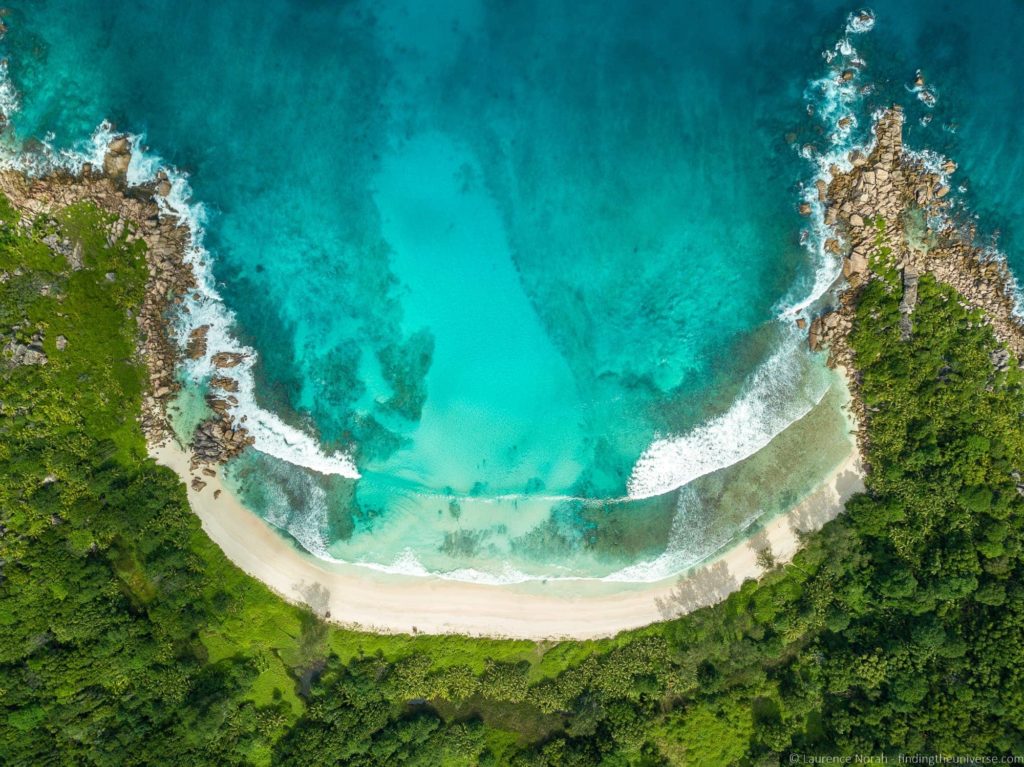
First stop on your trip will be the island of Mahe, and our itinerary has you spending four nights on Mahe, two nights on Praslin and one night on La Digue. Of course, one of the main attractions of the islands are the spectacular beaches, and you are welcome to focus on visiting those on your trip if you prefer.
You’re also more than welcome to chill out by your hotel pool! But, for those of you looking to get a bit of local flavour, this itinerary includes some of the sights and activities that we think a visitor to the Seychelles will really enjoy. But don’t worry, there are plenty of beaches in here too – although we also recommend checking out our guide to the best Seychelles beaches for more inspiration.
This 1 week Seychelles itinerary assumes you have a rental car but you can also get around by taxi, public bus, or join a tour to see almost all these sites – see the section on transportation after the itinerary for more information on getting around, as well as the section on tours for specific tours we suggest.
Day 1 – Mahe
Mahe is the most populated island in the Seychelles, and also the largest granitic island in the Seychelles archipelago. The Seychelles islands are unique in that they are the only oceanic granitic islands in the world.
They were formed when the Seychelles plateau sank, so the islands that exist today are in fact 70 million year old mountain tops. In some places, the land sank just below the sea, and here coral islands have formed, which are totally flat.
Anyway, back to Mahe. As the largest and most populous island in the Seychelles, with around 80,000 Seychellois calling it home, Mahe is the island you will arrive on as all international flights to and from the Seychelles arrive here.
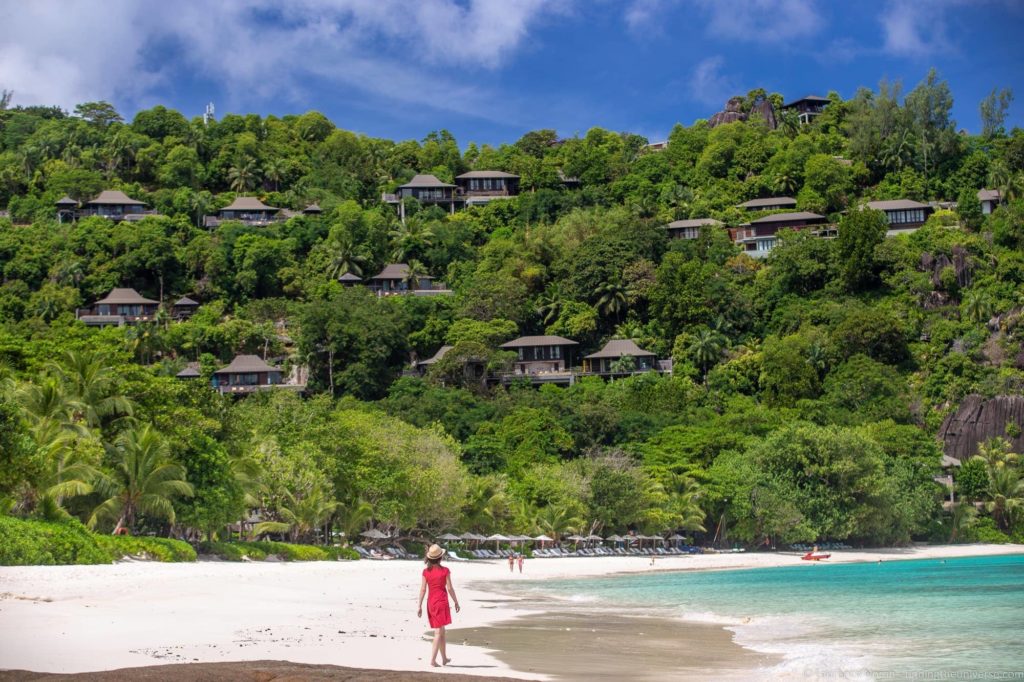
The island isn’t that big, at around 17 miles long, but we think that scheduling three nights / four days here at the start of your Seychelles trip will give you time to see a great many of the islands attractions and beautiful beaches.
For your first day, much will of course depend on your arrival time, but we think that you shouldn’t try and do too much as you’ll need to acclimate to the temperature and humidity.
So we’d suggest heading to your accommodation and relaxing a bit, picking up your hire car (if you booked one), and maybe heading to one of the island’s beaches to start your holiday in style.
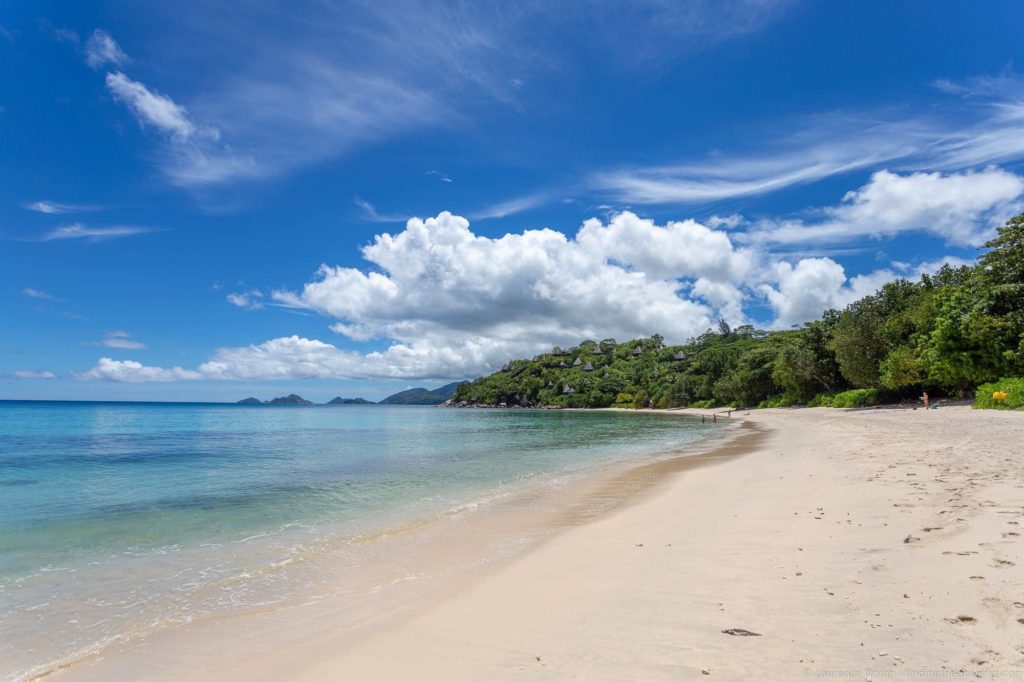
Of course, which beach you head to will depend on where you are, but we’d recommend Anse Intendance or Anse Louis if you’re on the south end of the island, or Beau Vallon if you’re on the north end of the island. Beau Vallon is also a good location for sunset, and for swimming if you have kids, as the water is most calm.
Day 2 – Mahe
On your second day on Mahe we recommend you take a bit of your day to explore the capital of the Seychelles – Victoria. This is the smallest capital in the world, so it won’t take you too long to explore.
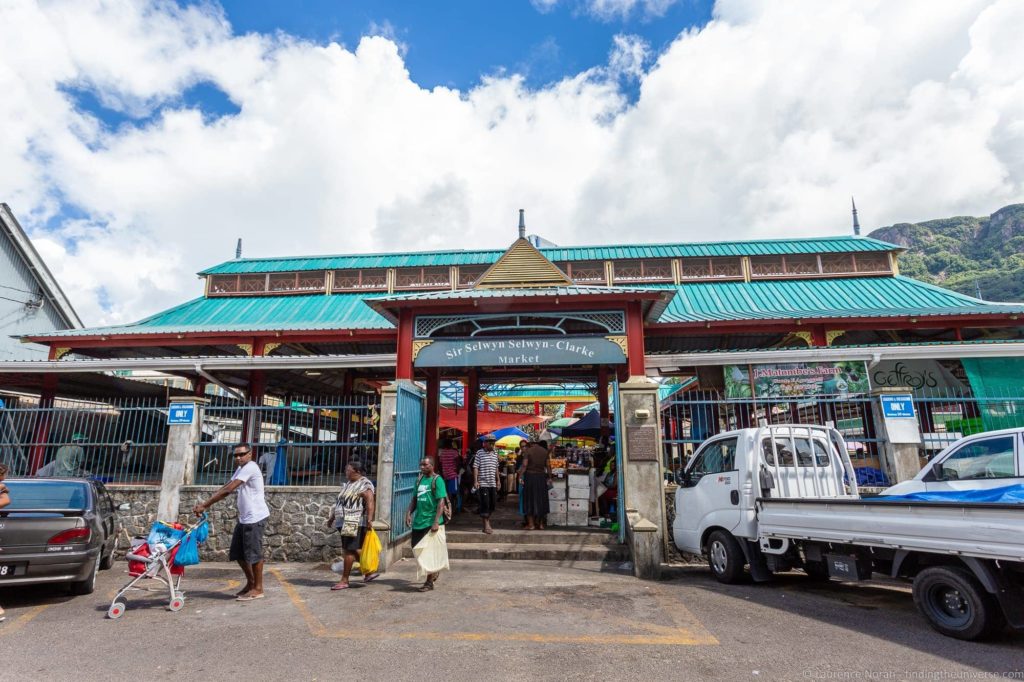
Highlights include the colourful central market and the clock tower in the centre of town. There’s also a small but very interesting natural history museum, if you want to learn a bit about how the islands formed and their unique flora and fauna.
From Victoria, we suggest taking the mountain road known as Sans Souci, which will give you a different perspective of the island. This road leads high up into the mountains, and there are a number of attractions along the way. Those of you who love hiking will appreciate the fairly strenuous hike known as Capolia, which takes 90 minutes to 2 hours, depending on your fitness.
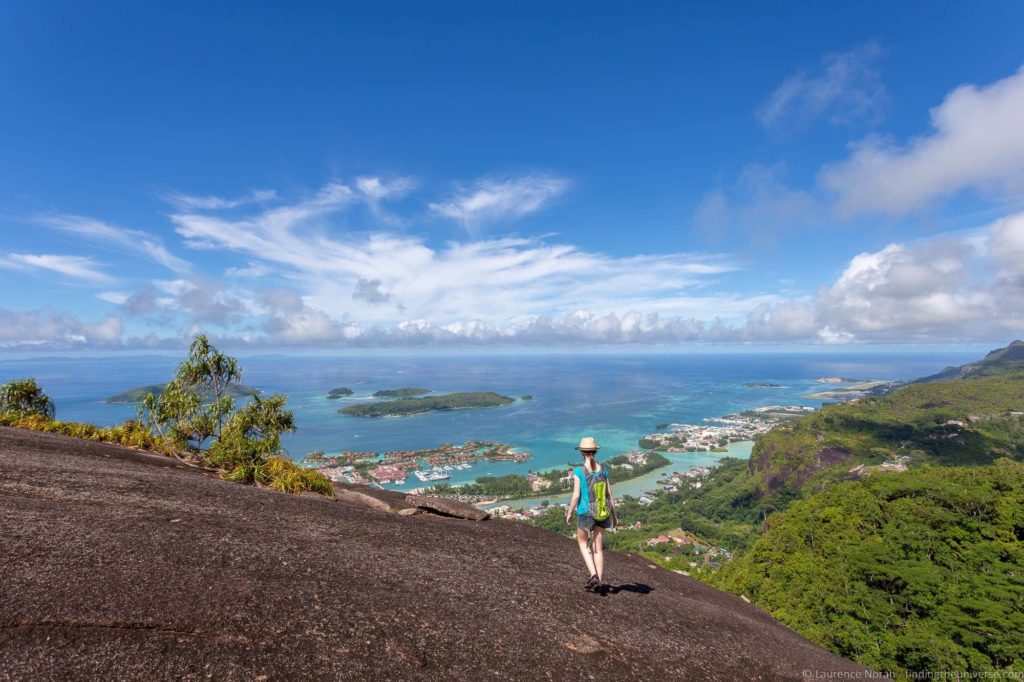
This is a fairly steep hike up onto the giant granite boulders behind Victoria, which will reward you with spectacular views of the east coast of Mahe, as well as across the St. Anne Marine National Park. On a clear day you’ll also be able to see Praslin and the islands around Praslin.
Parking is available by the road side here, and the path is marked with a large sign at the start, although be sure not to leave any valuables in your car if you are driving yourself.
Further along the Sans Souci road you will come to the Mission Lodge, which was the site of a school for liberated African slaves on the islands. There is not a lot left to see of the school, but the scenery is beautiful as are the views.
From the Mission Lodge the road starts to wind down the other side of the hill, and you’ll pass through the Seychelles Tea Plantation. When we visited in 2018, this was undergoing renovation, however it is due to re-open to visitors soon. There is also a nearby hiking path if you want to explore some of the unique fauna of this area.
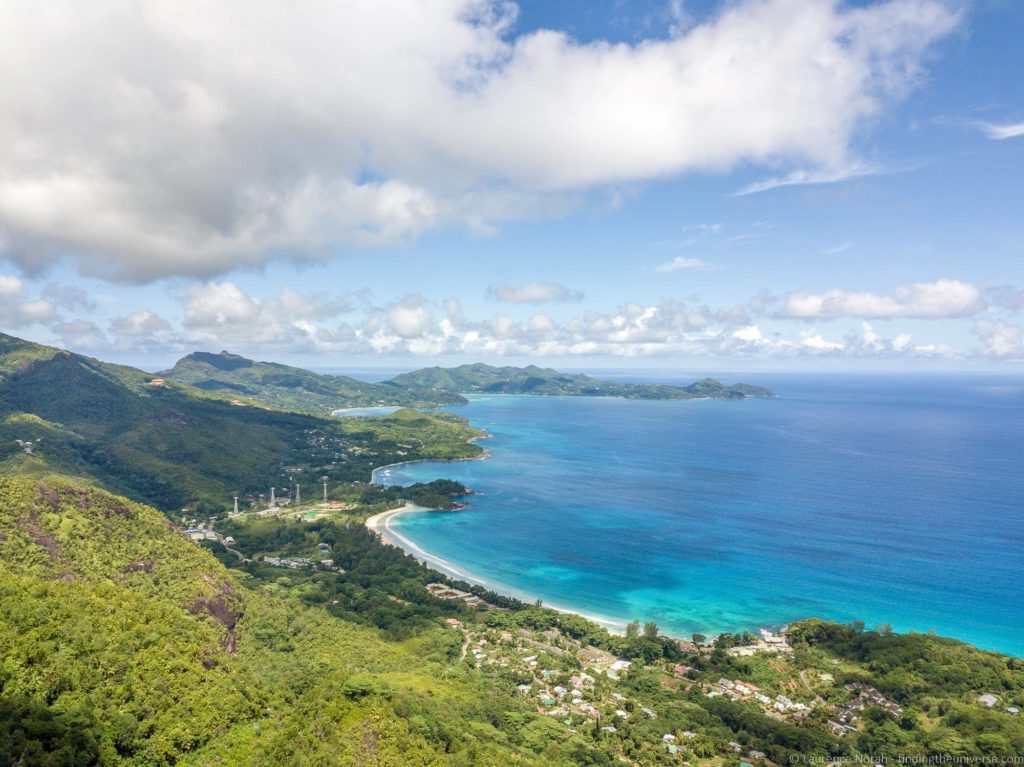
Once you’re done with the Sans Souci road, you will find yourself on the west coast, where no doubt it’ll be time for a swim and the beach. There are a number of beaches along this part of the coast that are worth visiting, including Grand Anse, Port Launay and Baie Ternay.
The latter does require a short 10 minute walk, although the drive to the beach also reveals a few quite secluded beach spots that you might have all to yourself!
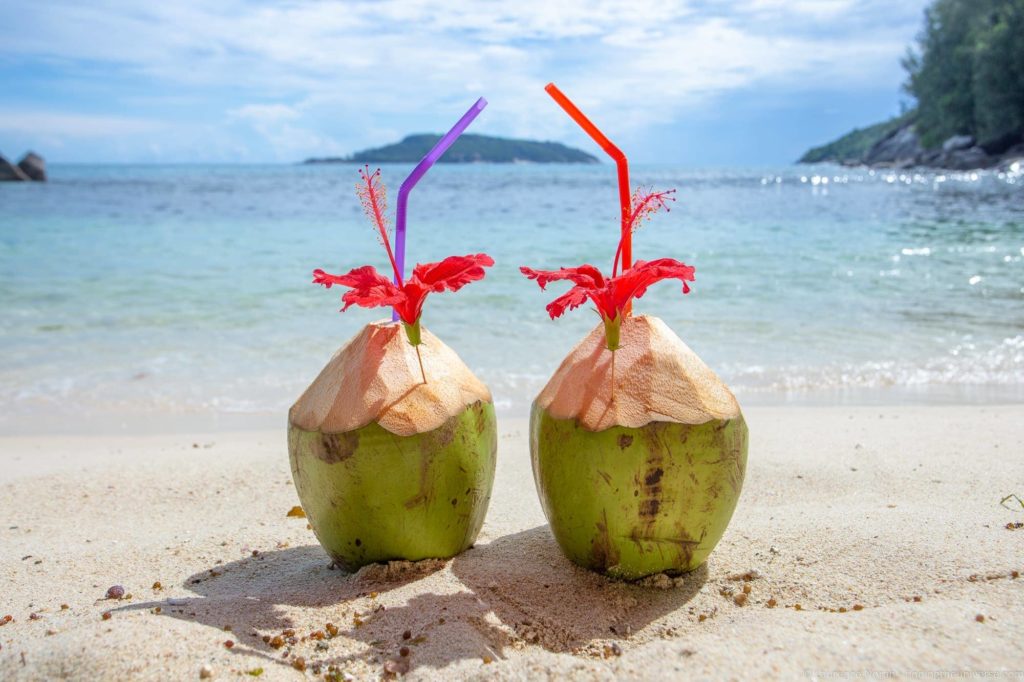
Day 3 – Mahe
For your third day on Mahe, we think you should explore the south of the island, which is one of my favourite parts of Mahe. This part of the island, being a little further away from the capital, is a little less developed, but has many attractions to explore. In terms of geography, generally the south can be thought of as being anywhere south of the airport.
First stop on our tour is the “Craft Village”. This, found on a former plantation (you can still tour the plantation home for free), is a village where local craftspeople create all kinds of products for sale.
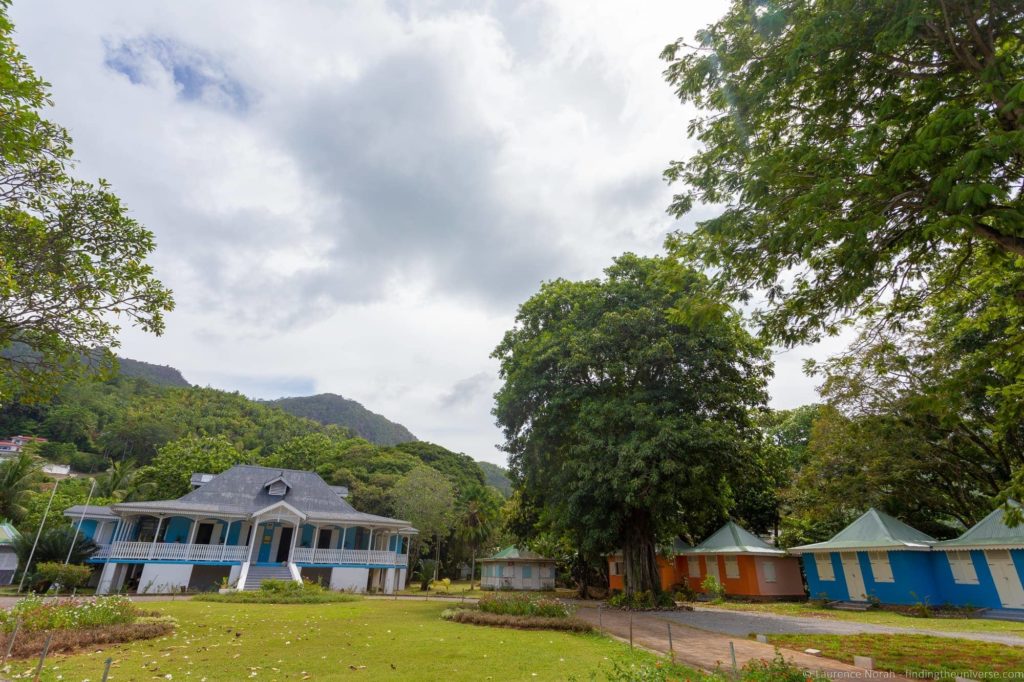
These are very reasonably priced, and you’ll find a range of items here from t-shirts to candles to hand carved fridge magnets. I’d suggest that this is an excellent place to go souvenir shopping, as you are pretty much guaranteed an authentic, locally made product, and that the money will go straight into the hands of the crafter.
This is also a good opportunity to chat with the local people about their lovely islands, and learn a bit more about what it’s like to actually live here.
From the Craft Village, the next stop is another former plantation, just two minutes drive away. Found at the “Plaine St. Andre” is the Takamaka Rum Distillery, which produces the islands famous rum product – Takamaka rum. By your third day in the Seychelles, we’re sure you will have seen plenty of advertising about this rum, and you’ve probably even tried some.
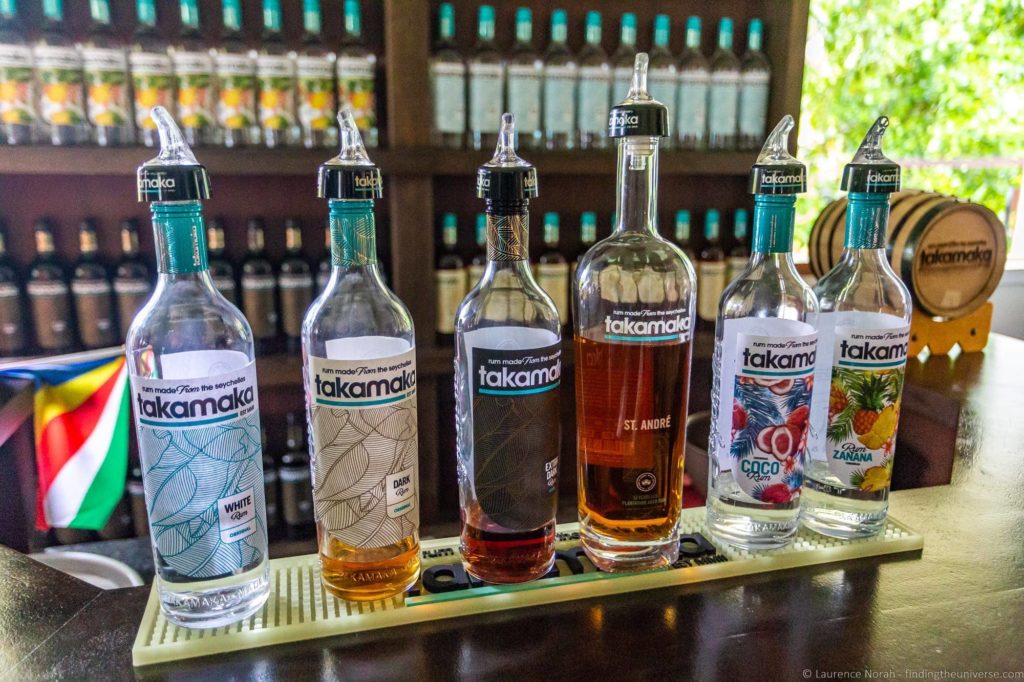
Well, now’s your chance to learn all about how it’s made! Takamaka rum is the only rum made on the island with locally grown sugar cane, and it comes in a variety of flavours.
Tours are run twice-daily (although the times seem to vary, so do call to check when these are running) and are relatively inexpensive, plus they include a tasting of all the varieties of rum!
You’ll also learn a bit about the history of the plantation as well as slavery in the Seychelles, making this, all in all, a worthwhile location for a visit. Naturally, you can also buy some rum to take with you as well.
From the Takamaka rum distillery it’s time to head even further south, and explore more of this wonderful part of Mahe. We highly recommend going right to the far south of the island, down the Grand Police road, past Anse Intendance, and exploring one or more of the three beaches down here – Anse Bazarca, Anse Petit Police and Anse Grand Police.
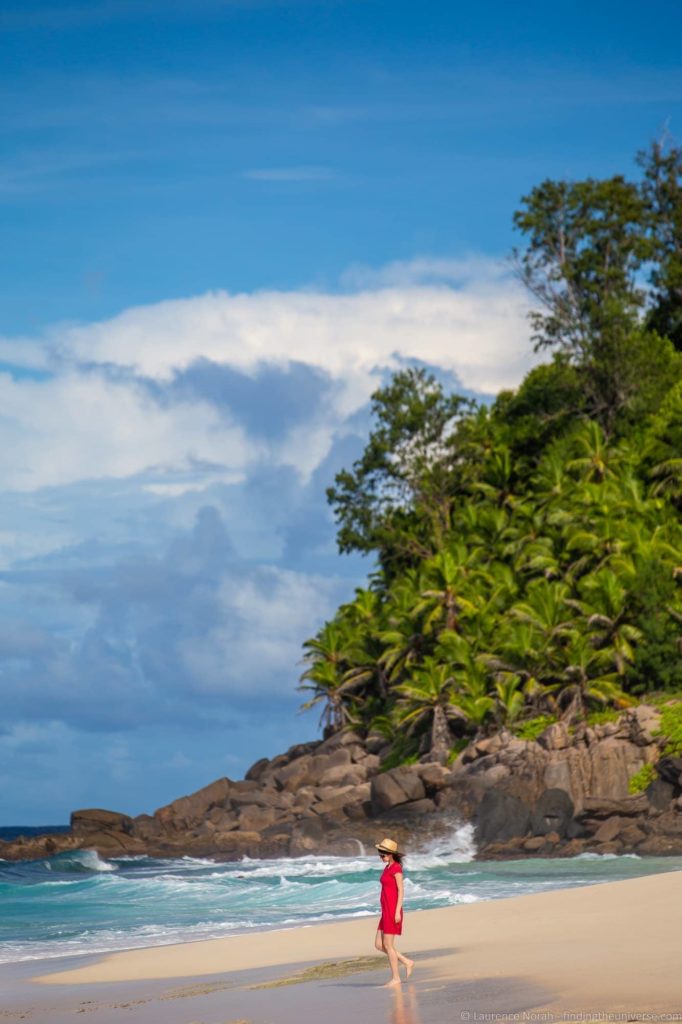
Their far flung location means they get very few visitors (except for locals on the weekends!), and here you can really live the dream of having your own white sand paradise beach location to yourself. Just heed the warning signs regarding the currents as it can be dangerous to swim here at certain times of the year.
You can also wind around the south of the island to some of the other beautiful beaches in the area, including Anse Soleil, and Petit Anse.
Petit Anse is now the location of the Seychelles Four Seasons, but the beach is open to non-guests of the hotel although they do limit the number of visitors. You just need to sign in at the security gate and then park and walk down from the parking area.
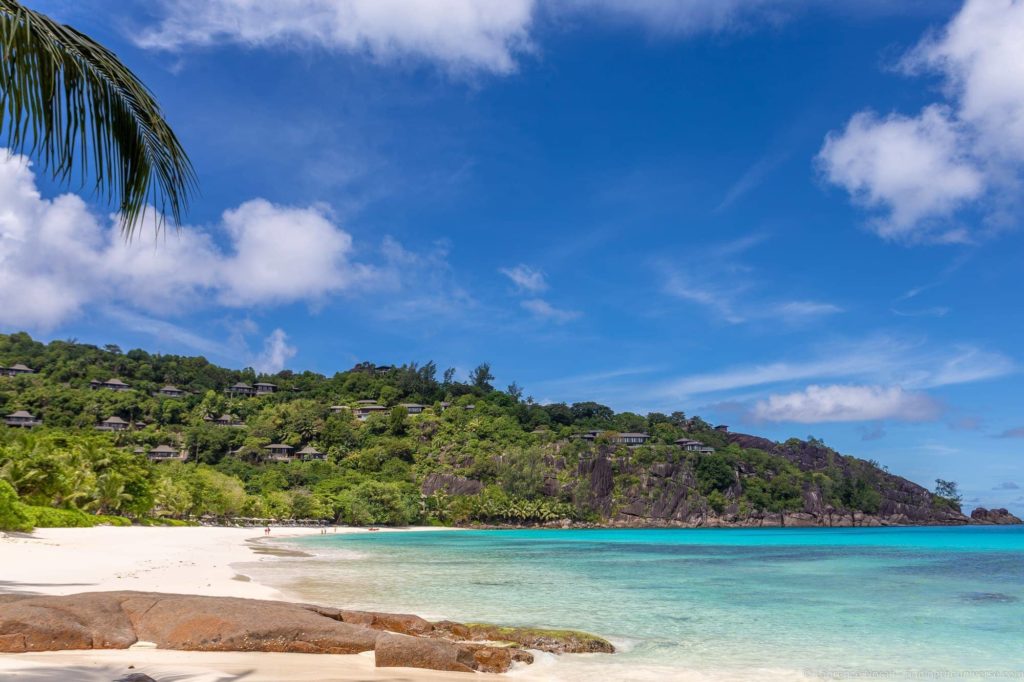
Other pretty beaches in this area include Anse Takamaka, Baie Lazare and Anse Louis. In terms of food in this part of the world, popular and recommended stops include Surfers Cafe and the Anchor Cafe.
Day 4 – Praslin
On the morning of your fourth day, we suggest you take the early morning ferry across to Praslin (the main ferry provider is Cat Cocos) . This takes around an hour, and leaves from the Inter Island ferry port in Victoria.
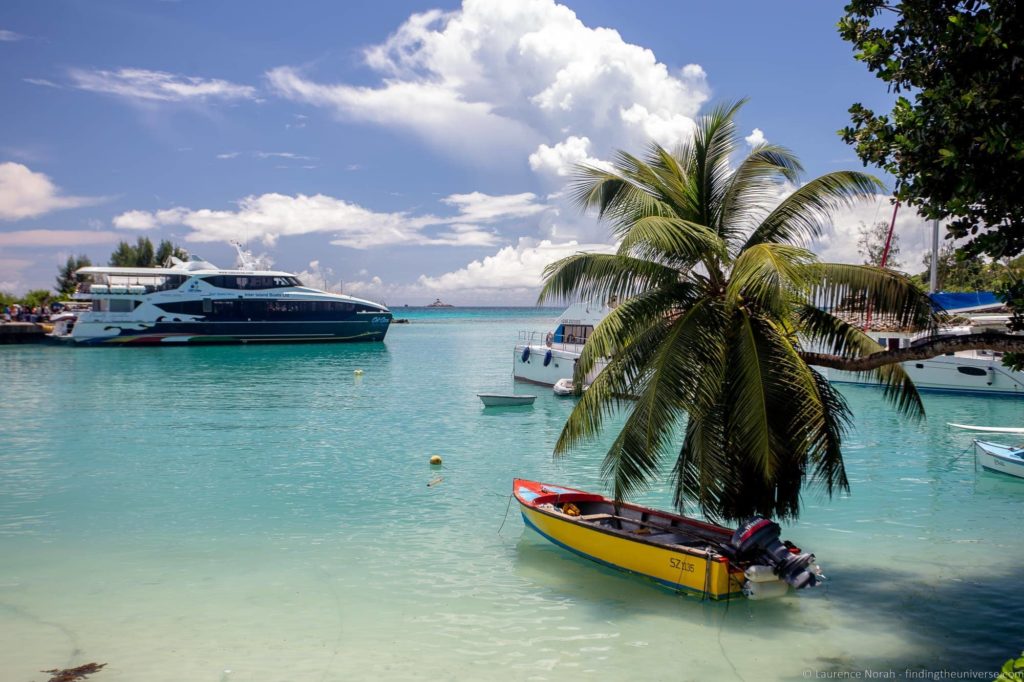
There are also loads of other ways you could visit Praslin or divide your time. If you prefer, you could also take the afternoon ferry on Day 3 and spend an extra night on Praslin, it’s entirely up to you.
If you want to reach Praslin faster, you could take 15-minute flight from Mahe with Air Seychelles, or there’s also the option to charter a helicopter of course. And, if you’d prefer to do everything from Mahe, you can also visit Praslin as a day trip from Mahe as well.
With one full day on Praslin, our suggestion is to take in the fantastic Vallee de Mai, and visit one of the world’s best beaches. A hire car on Praslin will make getting around easier, but public transport also serves the major stops around the island. You can also take a day tour like this.
We’re going to start with the Vallee de Mai on Praslin. This is a UNESCO world heritage site, and the major tourist attraction on the island. Here, one of the Seychelles most unique endemic plants grows – the giant Coco de Mer palm.
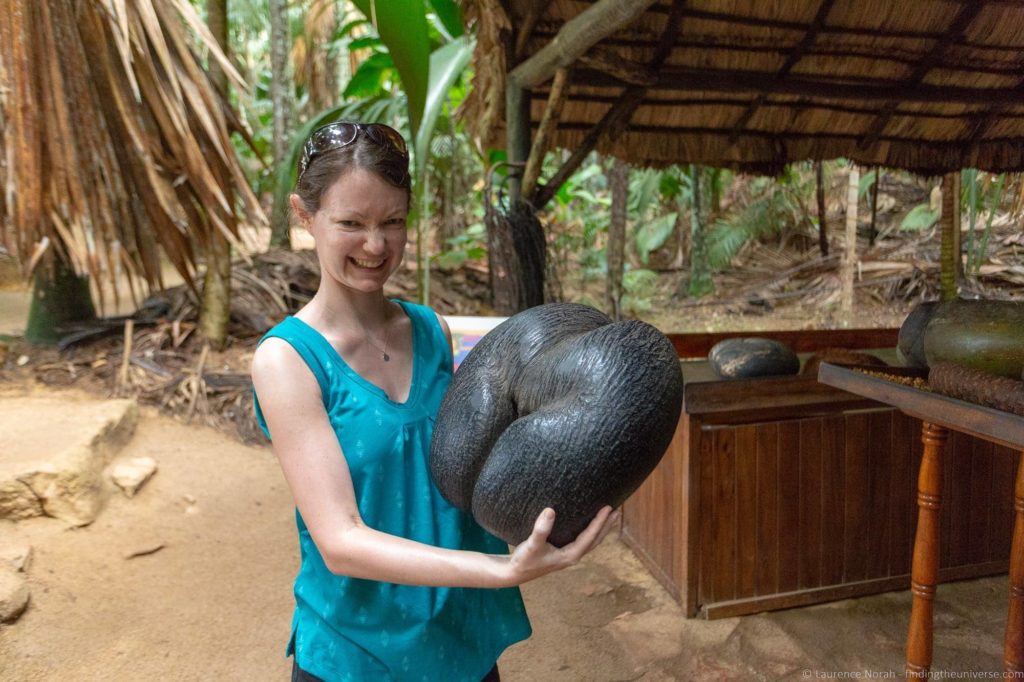
These trees, which grow as either a male or a female, have the world’s largest nut. Inside the nut you can find the world’s largest seed – which takes up to seven years to germinate!
The name, which translates as Coconut of the Sea, came about because for many years these nuts would wash up on foreign shores. With no idea where they were coming from, they were given the name that suggested they came “from the sea”.
Of course, when the Seychelles islands were finally discovered, the source of the mysterious nuts was also found – but the name stuck.
Today, the majority of the world’s Coco de Mer palm trees grow in the Vallee du Mai, and a walk through this beautiful and peaceful valley of giant trees is a must for your visit to Praslin.
Note that the nuts are fully protected, so don’t try to take one home with you – this is possible, but you need to go through the official channels and paperwork! Whilst you’re here, keep an eye out for the Seychelles black parrot also, which is commonly found in the valley.
Once you are done with the Vallee du Mai, it’s time to visit some of Praslin’s spectacular beaches. One of the most famous of these is Anse Lazio, which regularly tops lists of the best beaches in the world.
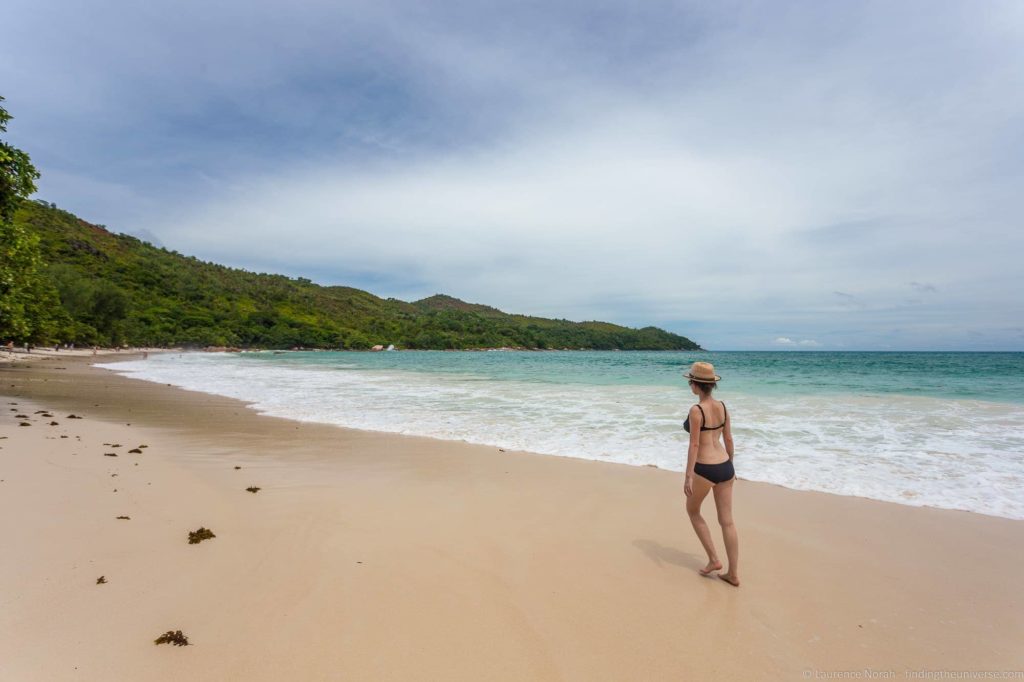
To be honest, whilst Anse Lazio is indeed stunning and worth a visit, there are multiple gorgeous beaches in the Seychelles – many of which are a lot quieter as they are not so famous! But still, Anse Lazio is beautiful, and there is an excellent seafood restaurant here (Bonbon Plume) where you can have some lunch as well.
You can either stay here for the rest of the day, or work your way back around the island’s other beaches – it’s up to you.
Day 5 – Praslin / Curieuse Day Trip
For your fifth day in the Seychelles, we recommend taking a boat tour of some of the islands around Praslin (you can also do similar boat tours from Mahe as well). The Seychelles archipelago has over 100 islands, each of which is unique, so we think that exploring some of the smaller ones is an essential part of any trip to the Seychelles.
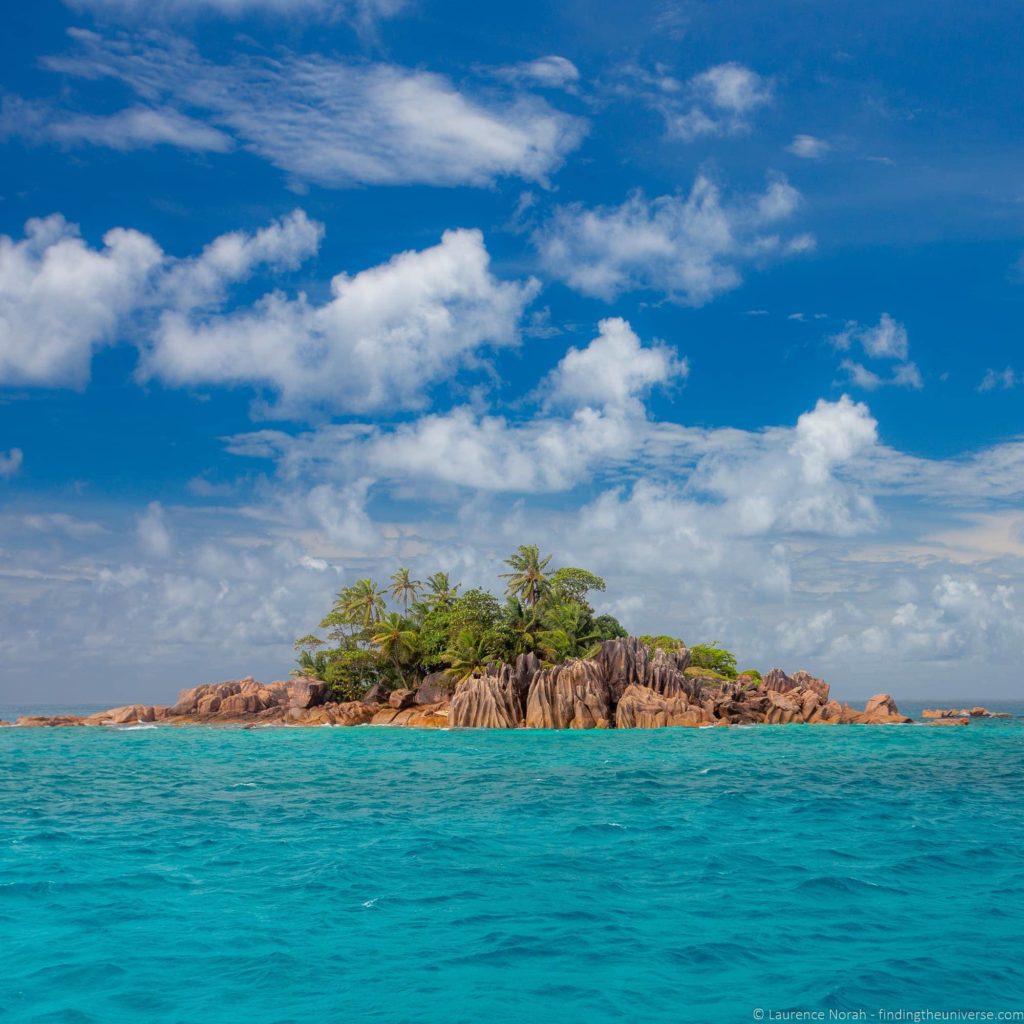
There are a number of boat tours that operate from Praslin which visit a number of the islands around Praslin. The itineraries vary slightly, as do the islands visited, but most of them are a full day trip, such as this one, that includes lunch, soft drinks and transfers from your hotel to the jetty at Baie St. Anne.
Generally, most boat excursions include 2 or 3 of the following islands: Curieuse, Cousin, Felicité, Coco, Sister, and/or the small island of St. Pierre – the latter of which is just a small granite outcrop that is good to snorkel around (you don’t actually land on it).
An appealing island for many visitors is Curieuse as this is the best place to meet the Aldabra Giant Land Tortoise. This is a massive tortoise species, endemic to the Seychelles, which can grow to an excess of 600lb and 200 years in age.
Curieuse is probably the best place to see them on this itinerary as they are not fenced in and can roam freely. Fans of wildlife, and in particular bird lovers, may also want to visit Cousine, as this is an excellent place to see a number of the birds of Seychelles, including the Seychelles Magpie Robin, Fairy terns, white tailed tropic birds, and more.
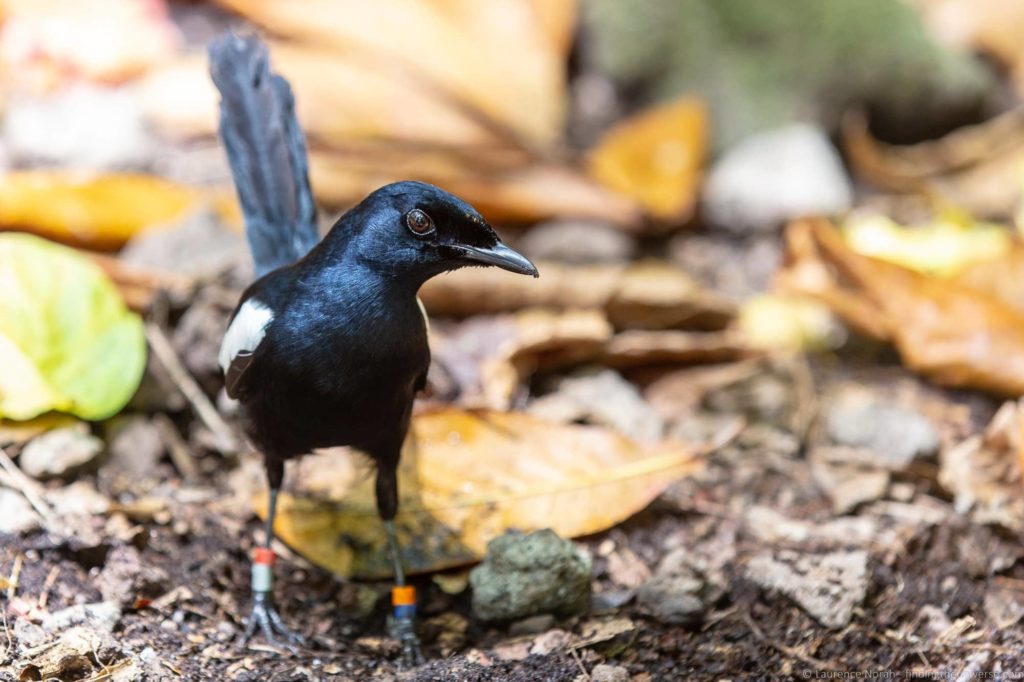
There are a number of tour options, including this option by glass bottom boat and this speedboat option.
Whichever operator you use, make sure to bring swimming clothes, sunscreen and plenty of insect repellant!
Day 6 – La Digue
For your sixth day in the Seychelles we suggest you take the morning ferry across to La Digue. This is a fifteen minute ride and there are two companies offering regular service – Cat Cocos, and the Inter Island Ferry.
La Digue has a very different vibe than the other islands you will have visited so far. There are very few cars, and most visitors get around by bike or on foot. The island isn’t very big, taking around 30 minutes to cycle from one end to the other, but it has a number of attractions that make it worth visiting.
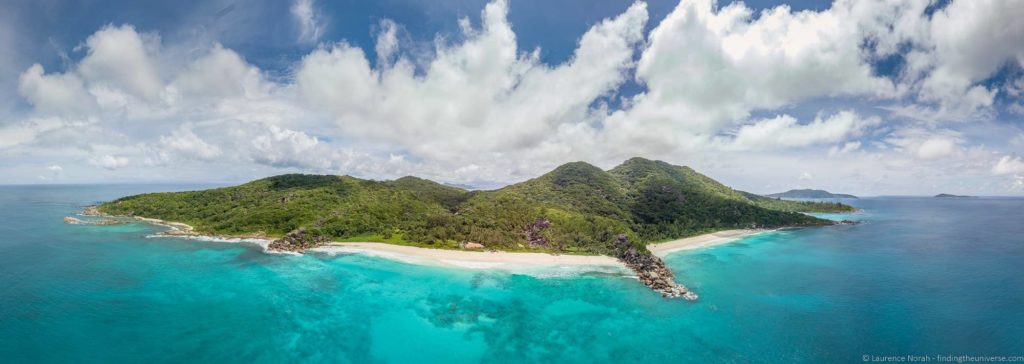
First, and at the top of most visitors lists, is a visit to Anse Source D’Argent. This is a beach at the south end of the island, with out of this world granite rock formations surrounded by palm trees, turquoise waters and pale white sands.
It really has to be seen to be believed, and whilst it does get busy here as the day progresses, is very much worth visiting. It’s also an excellent spot for watching the sunset. Do be aware that you do have to pay to visit the beach as access is through the L’Union Estate, which is privately owned.
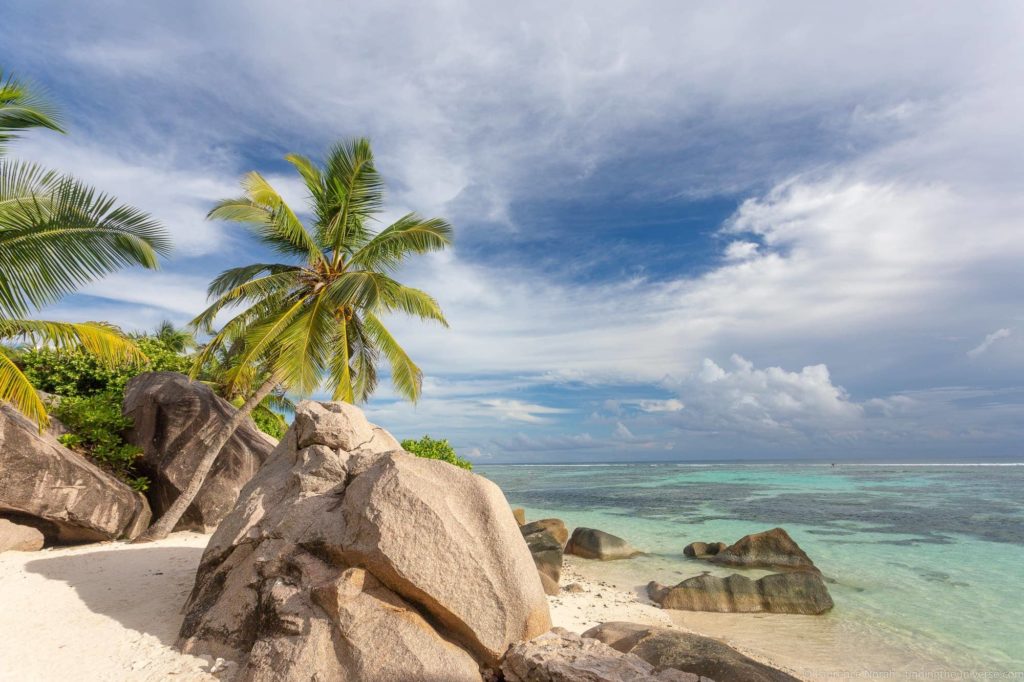
If you don’t mind a bit of a cycle, it’s worth taking the road to the east side of the island to visit Grand Anse, another spectacular beach. It can be a bit busy here, but you can escape the crowds by heading to Petit Anse instead, one cove along.
Alternatively, head around the north end of the island, there’s a road which leads past numerous beaches, one of which we’re sure will take your fancy.
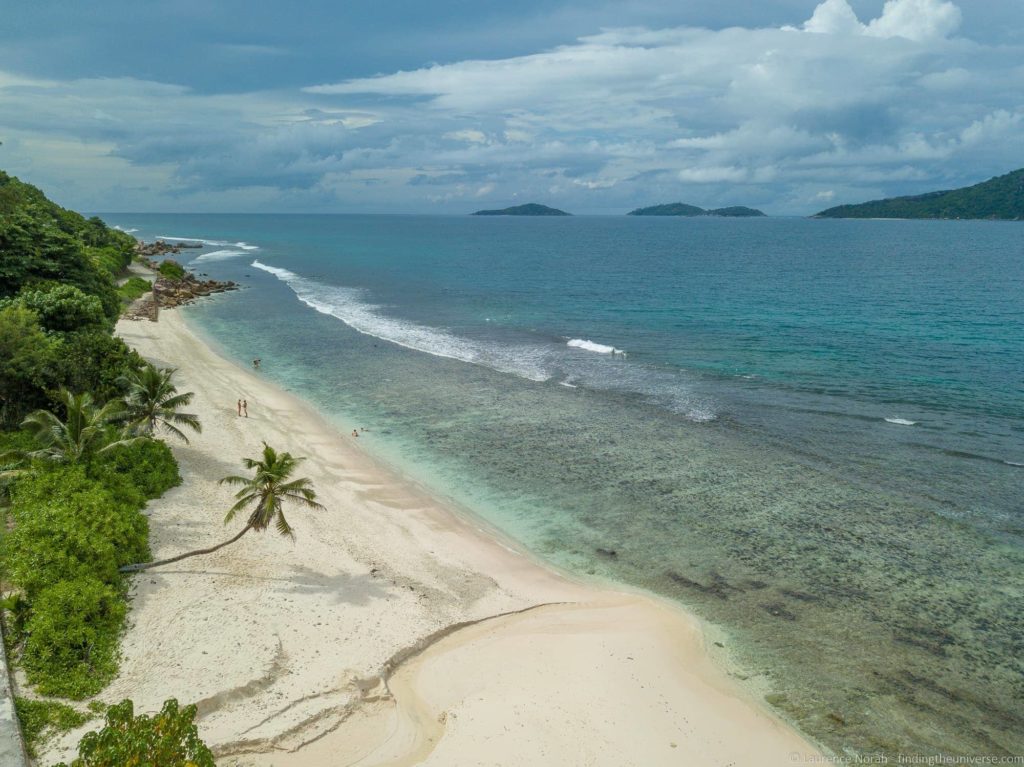
Finally, while you’re on La Digue you should try to catch a glimpse of the Seychelles Paradise Flycatcher. This endemic bird is critically endangered and native to La Digue. The best place to spot one is in the Veuve Reserve, a tract of wilderness that is set aside for the protection of these beautiful birds.
Note that if you’d prefer to stay on Praslin, you can explore La Digue as a day trip too. You can either do this on your own, by taking the ferry over, or you can take a 1 day tour of La Digue from Praslin.
Day 7 – La Digue & return to Mahe
For Day 7, our suggestion is to return to Mahe – you can take the ferry directly from La Digue to the connecting Praslin service, with a total journey time of around an hour an a half.
Of course, it’s up to you if you leave in the morning or afternoon, and this will depend on things like how much you want to see on La Digue, if you choose to stay on Praslin, and of course your flight time.
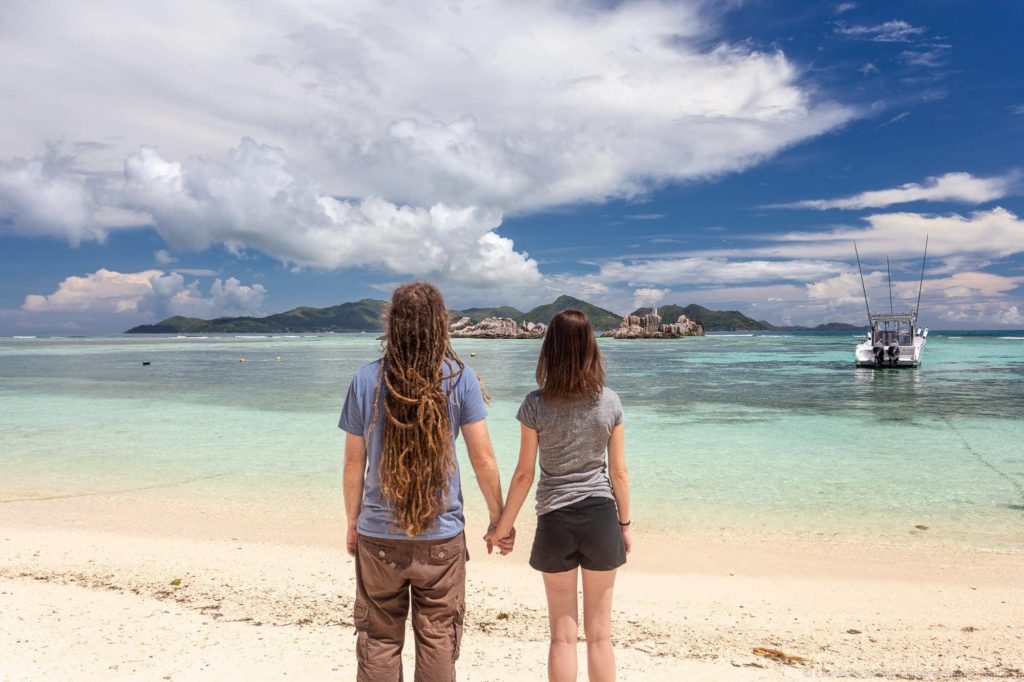
Our suggestion though is to return to Mahe and stay the night, so whatever time your flight is you’ll have no trouble getting to the airport. Once back on Mahe you can spend your last day and night finishing off any souvenir shopping, visiting a favourite beach, exploring a museum or garden, or just lounging by the hotel pool!
1 Week Seychelles Itinerary Overview
Here’s an overview of our Seychelles itinerary broken down day by day:
- Day 1: Mahe. Arrive, check-in, acclimatise and hit the beach
- Day 2: Mahe. Explore Victoria, drive Sans Souci
- Day 3: Mahe. Explore the south of the island
- Day 4: Praslin. Ferry from Mahe to Praslin, visit the Vallee du Mai
- Day 5: Praslin. Day trip to the islands around Praslin
- Day 6: La Digue. Explore the island
- Day 7: La Digue / Mahe. Return to Mahe, relax!
When is the Best Time to Visit Seychelles?
Traditionally, the best time to visit Seychelles for the hottest and driest weather has been around April, however, changing global climates mean that this is not as predictable as it used to be. Rain is possible at any time of year, especially on Mahe, where even in the dry season you might expect to get a passing rain shower in the afternoon. However it is unusual for rain to set in, and most rain will clear up fairly quickly.
The Seychelles islands are situated around 200 miles south of the equator, and as a result of this, they do not have the four seasons that more northern or southern countries experience. There are two main seasons in the Seychelles, the “North West” and the “South East”. These seasons refer to the directions that the wind is blowing from.
The North West runs from around the end of November through to March, and this time of year is particularly hot and humid. It’s also more likely to rain during this time, particular in the months of December through to February. This is the so-called “rainy season”.
The South East season runs for the rest of the year, with the driest part of the year typically from June through to September. The south east is a stronger wind, which means that it feels cooler on the islands, however this also means that the oceans are more disturbed, so the seas are a bit rougher, the water visibility for snorkelling and diving is reduced, and seaweed can wash up on the beaches as well.
Seaweed in the Seychelles
One of the most common questions I get from readers planning a trip to the Seychelles, is which beaches in the Seychelles get seaweed, and where to stay in the Seychelles to avoid seaweed.
For Mahe, the north side of the island tends to be more seaweed prone from November – March, which is during the “north-west” trade winds season. So if you visit during this time of year, you will want to stay on the south or east side of the island.
However, in general Mahe doesn’t get so affected by seaweed at this time of year, it’s Praslin that has more issues. If you are visiting Praslin between November and March, seaweed is common on the beaches on the north and west of the island. So head to the south and east coasts for a better experience.
The south east trade winds blow from around April through to October. At this time of year, beaches on the south and east of Mahe and Praslin are more likely to be affected by seaweed, so you will want to stay on the north and west side of the islands.
How to Get Around the Seychelles
There are two things to consider when visiting the Seychelles – how to get between the islands, and how to get around the islands. We’ll start with getting around each island first.
Getting around the islands
On the larger islands in this itinerary, like Mahe and Praslin, you will find your trip a lot easier if you hire a car. There are lots of car hire companies to choose from, with prices in the region of $50 – $80 USD a day.
A hire car will make getting to all the sights and attractions on the islands at your own pace much more pleasurable. Car hire can be booked in advance, at rental counters at the airport, or many hotels and guesthouses will also offer car hire.
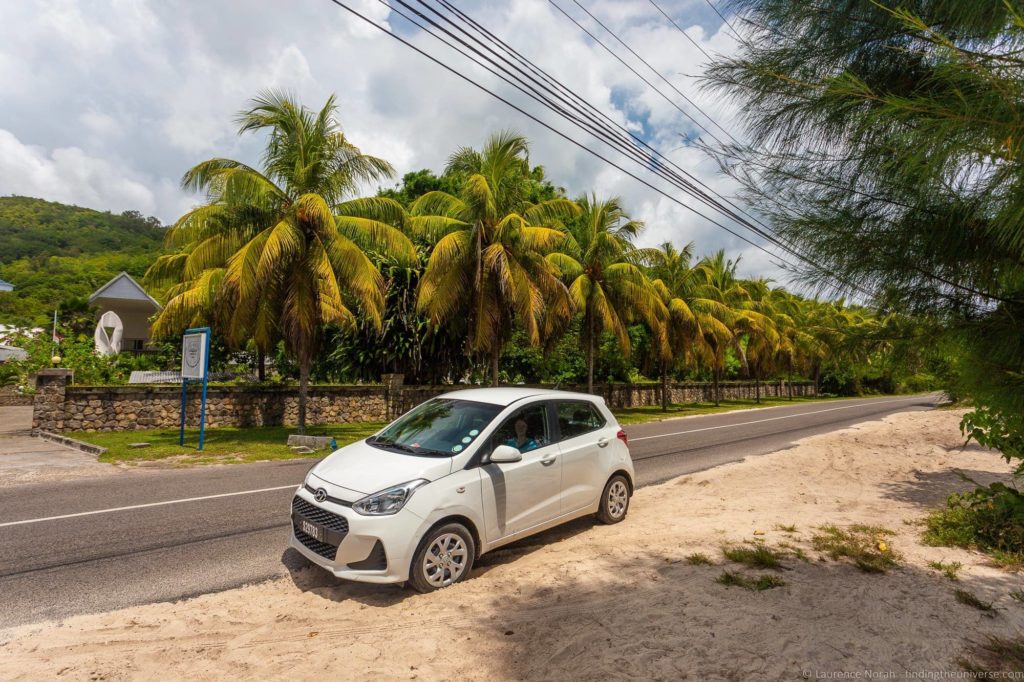
On Mahe and Praslin, there is also a regular public bus service which runs all around the island and covers the majority of destinations. This costs around 7 rupees per journey and is definitely going to be the cheapest way to get around, although it will take longer, and you are at the mercy of the bus service timetable of course. More remote locations, such as those off the beaten path beaches, might be harder to get a bus to.
Of course, there are also taxis available, which can be picked up at taxi stands or booked through your accommodation. You can also hire a private driver to drive you around for a half day or day, which may be a good deal if are traveling as a family or group. These will usually be the most expensive way to get around, but if you want speed and convenience, and don’t want to drive yourself, this is a good option.
There are also a number of tours if you’d rather not drive yourself. For example:
- This is a small group full day tour of Mahe
- This full day Mahe tour focuses on some of the best beaches in the Seychelles
- This is a fully customisable private tour of Mahe
- This full day tour of Praslin includes the Vallee du Mai and Anse Lazio beach
On La Digue, there aren’t many cars, and most visitors opt to rent a bike to get around. These can be hired at the jetty on arrival, or your guesthouse / hotel will likely have bikes for hire.
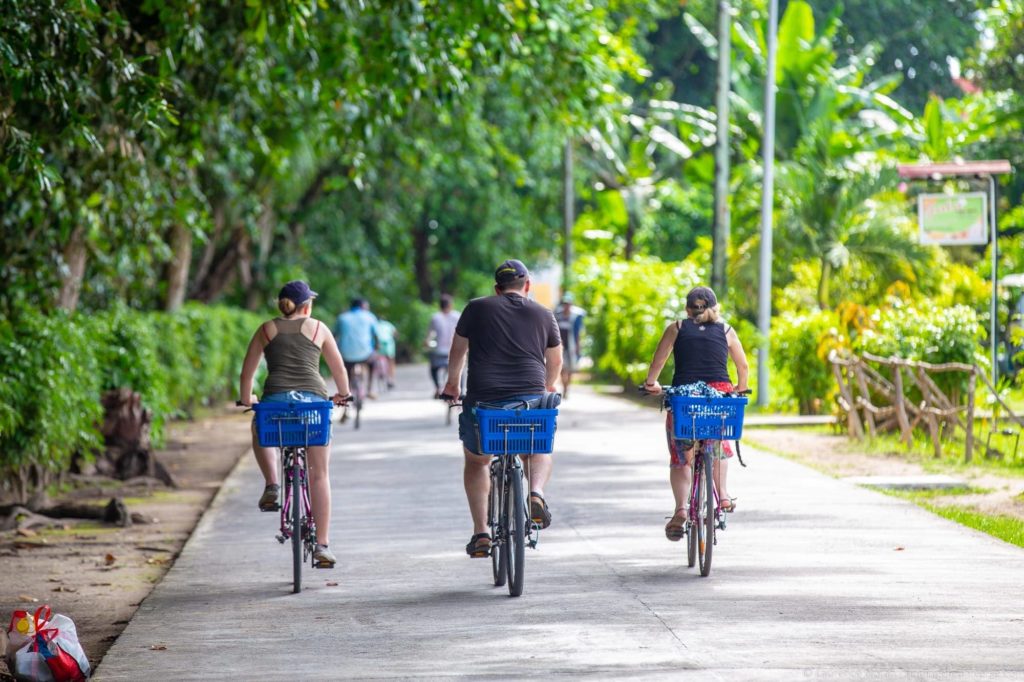
Expect to pay around 100 rupees a day for bike hire. There are also some golf carts operated by hotels, which offer transfer services.
Getting between the Seychelles Islands
There are two main ways to get between the islands in the Seychelles – you can fly, or you can take a boat.
For the islands in this itinerary, there are regularly scheduled flights between Mahe and Praslin operated by Air Seychelles, with a flight time of around fifteen minutes.
There is also a helicopter charter service operating between Mahe, Praslin and La Digue by ZilAir, although this is of course more expensive.
The other option for travelling between the islands is to take a boat, with a fast ferry service (Cat Cocos) operating between Mahe and Praslin (about 1 hour journey time), and Praslin and La Digue (15 minute journey time).
This is the most cost effective way to travel between the islands on our itinerary, and unless you are in a particular rush, is the option we recommend.
You can see prices and book in advance online for the boat here, flights here, and helicopter here.
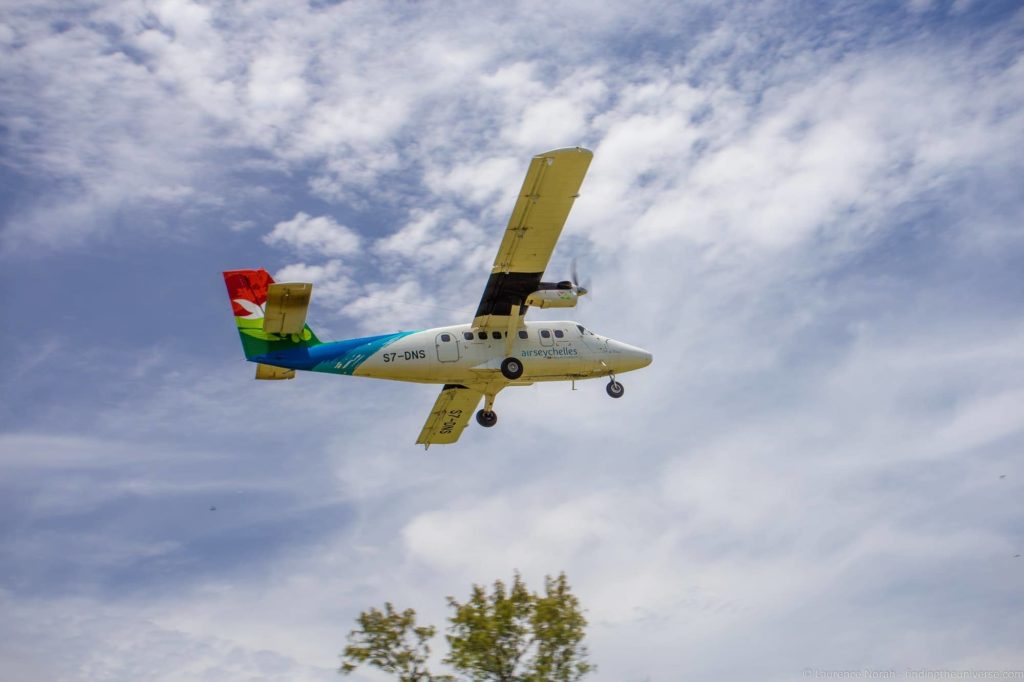
Practicalities for the Seychelles
Currency in the Seychelles
The currency in the Seychelles is the Seychelles rupee, which comes in note and coin form. Rupees can be widely withdrawn from ATM’s around the country, and most locations will also accept credit cards. In some locations, especially higher end hotels, prices may be listed in USD or Euros, and these establishments will also usually accept payment in these currencies as well.
Electricity in the Seychelles
Seychelles uses a 240v standard, like Europe. Plugs are the same three pin plug as you find in the UK, so travellers from continental Europe and the US, as well as other countries that don’t use the three pin system will need an adaptor such as this one.
Travellers from countries which use a 110v system, such as the USA, will need to check that their equipment is compatible with 240v. In our experience, electrical items like camera chargers and laptops are compatible, but higher power items like hair dryers, hair straighteners, and kettles are not.
Always check your appliance before plugging it in – supported voltages should be clearly marked on the plug or adaptor. You are looking for either 220-240v, or 110-240v.
Internet in the Seychelles
Internet in the Seychelles is a relatively expensive commodity. That said, all the properties that we stayed at in the Seychelles included free Wi-Fi, which varied in speed from relatively slow to quite fast.
It’s also possible to pick up a SIM card if you have an unlocked device, and get data through one of the providers in the Seychelles. For an up to date list of prices and packages, check out this page which lists the best data sim packages for the Seychelles.
Safety in the Seychelles
The Seychelles are a relatively safe destination to visit, with violent crime being uncommon. In recent years there has been a rise in petty thefts however, and visitors need to be mindful of their belongings.
This is especially the case when visiting beaches or leaving your car unattended. Don’t leave any valuables unattended on beaches, or visible in cars. If you are renting an apartment or house, be sure to keep doors and windows locked when you are out.
A number of popular beaches on Mahe in particular have police officers in attendance, and we were often advised not to leave bags alone on the beach when going for a swim. Our advice would be not to take valuables to the beach if you can help it – leave them in your accommodation. Many rooms include a safe where you can store valuables.
Drinking Water in the Seychelles
The tap water on the three islands in this itinerary, Mahe, La Digue and Praslin, is treated and safe to drink. On La Digue the water is quite hard and has quite a “hard” taste, however it is safe to drink.
We drank tap water during our whole stay on the islands and had no problem. If you don’t like the taste, bottled water is widely available.
Note that on many of the other islands, the water is not drinkable. Tour operators will generally provide you with drinking water and other soft drinks, or of course you can bring your own.
Vaccinations & Health in the Seychelles
Unlike many African nations, the Seychelles has no tropical diseases to worry about like Malaria or Yellow Fever. If you are visiting from a country which suffers from certain diseases, or have recently travelled through these nations, you might need to show proof of vaccinations. This is particularly the case with Yellow Fever.
The main risk facing most visitors is dehydration and sunburn – being near to the equator means that the sun is especially strong, and many visitors get a bit of sunburn. We advise drinking plenty of fluids during your visit to minimise the risk of dehydration, and reading up on the signs of dehydration so you can recognise it.
We also highly recommend travelling with a packet of oral rehydration tablets and taking one a day to keep your salt levels up as you lose a lot of salt through sweat.
To prevent sunburn, we suggest packing the most protective sunscreen you can find (high SPF rating) and applying it liberally before you go in the sun, and also to re-apply after swimming or exercise. We’d also recommend wearing a hat and advise trying to minimize your exposure to the sun during the hottest hours, between 11am and 2pm.
Food in the Seychelles
Food in the Seychelles is a detailed topic that deserves its own post, which is why I created a guide to the best food in the Seychelles to help you out – this also includes some restaurant recommendations.
In general though, food in the Seychelles is a mix of Creole and Indian flavours, and heavily features fresh seafood, as well as chicken and pork. Naturally ther are also lots of fruits and fresh fruit juices to try, with availability depending on the season you visit.
If you can, we definitely recommend trying the bananas, mangos and papayas if you can, as well as the fresh lime juice.
Driving in the Seychelles
Vehicles in the Seychelles drive on the left, and the majority of vehicles use a manual transmission, although automatic vehicles can be rented if you specify this. The speed limits are fairly slow, but distances are not too great, so it won’t take you too long to drive anywhere.
The exception to this rule is during rush hour, which tends to be from 7am – 9am in the mornings, and 3.30pm – 5.30pm in the evenings. This is mainly on Mahe, with traffic around Victoria and the airport often moving slowly as people travel to and from work.
Most of the roads are one lane each way with limited passing options, so the traffic during rush hour ends up going very slowly. We’d advise avoiding driving too much around Victoria and the airport at this time if you can!
Where to Stay in the Seychelles
There is a huge range of options when it comes to accommodation in the Seychelles, although this tends to fall into the midrange through to luxury category. Camping is illegal, and there are no hostel style accommodation options.
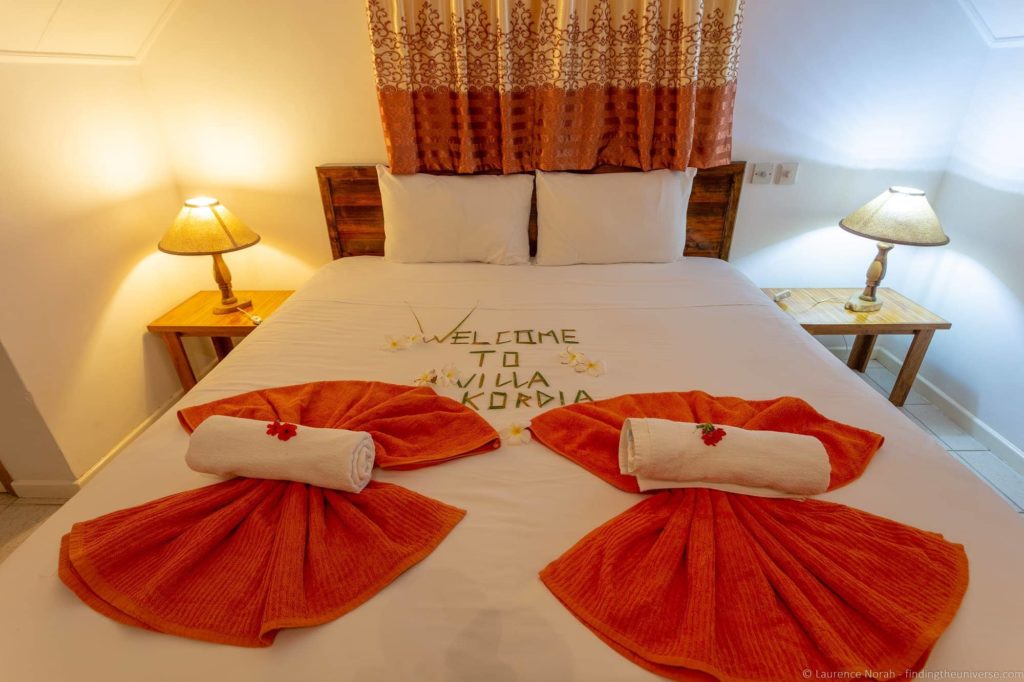
There are however lots of options, including various self catering options that are well priced in the budget to mid-range category, and there are some excellent high end properties on the islands.
Here are some options to consider for the three islands in this post, across a range of budgets.
Where to Stay on Mahe
Mahe is the largest island in the Seychelles, and there are a lot of options for accommodation around the island. These range from guesthouses through to mid-range and luxury hotels.
Some options we suggest you check out include the following. These are ordered approximately by price, from lowest to highest.
- Calypha Guest House – this is a great value and well rated guesthouse in the north part of Mahe. Rooms are en-suite and there’s a restaurant on-site serving Creole food
- Maison D’Aaryan – just a few minutes from the airport and 550 yards from Anse aux Pins beach, this well reviewed budget guesthouse offers en-suite family rooms and apartments
- Ocean View Guesthouse – a highly rated and great value guesthouse option a few moments walk from Beau Vallon Bay beach
- Villa Vanilla – a well rated and good value mid-range option near Port Glaud, just 650 yards from the beach. All rooms are en-suite, with some offering sea views
- Coral Strand – a well reviewed mid-range option on the ever popular Beau Vallon Bay beach
- Le Meridien Fisherman’s Cove – found at the end of Beau Vallon Bay this is a good high end property with pool, spa, on-site restaurants and bars.
- Constance Ephelia – a wonderful luxury property with two stunning beaches, a range of bars, pools and restaurants
- Four Seasons – found on the south end of the island on one of my favourite beaches on the island, this is a wonderful luxury property.
- MAIA Luxury Resort and Spa – if money is no object, check out this resort. Each all-inclusive room comes with its own butler, private infinity pool, gazebo and kitchenette. Definitely a stay you will not forget.
Where to Stay on Praslin
Praslin is the second largest of the islands in the Seychelles, but the population is much lower than Mahe – around 7,500 people, versus almost 80,000 on Mahe. As such, there are fewer hotels to choose from.
Here are some options to consider for accommodation on Praslin. Again, these are across a wide range of budgets, from least to most expensive.
- Chez Muriel – five minutes walk from Cote D’or beach, this great value guesthouse offers self catering double rooms with shared bathroom facilities
- Pirogue Lodge – found on Cote D’or beach, this property has superb reviews. Rooms have en-suite facilities and bathrooms, and there’s an on-site restaurant
- Le Chevalier Bay Guesthouse – Found on Anse Lazio beach, one of the best beaches in the Seychelles, this is an excellent mid-range option with en-suite rooms and an on-site restaurant
- Bliss Hotel – Found on Grand Anse beach, this is a popular mid-range option near the airport. Rooms have garden views and en-suite facilities
- Acajou Beach Resort – A well rated four star resort on the Cote D’Or beach. Two on site bars and restaurants as well as a pool. Room are en-suite, apartments with kitchens are also available.
- Raffles Seychelles – a five star luxury property on Praslin, just a short distance from Anse Lazio beach. Each villa comes with its own pool, and there’s a spa as well as 6 restaurants to choose from
- Constance Lemuria – offering five star luxury and spectacular beaches, as well as its own golf course, spa, restaurants and pools, this is an excellent luxury option with a range of suites and villas.
Where to Stay on La Digue
Despite it’s relatively small size compared to Praslin and Mahe, La Digue is very popular as a holiday destination and as such as a great many accommodation options.
The majority of these are in the budget to mid-range category, with a lot of self-catering and guesthouse style accommodation on offer. However, there are also some mid and high end properties to choose from as well.
Here are some accommodation options on La Digue to consider, again sorted approximately from least to most expensive.
- Villa Hortensia – Found in the hills, this is a popular hotel with good reviews. Rooms are air-conditioned with en-suite facilities.
- Chez Marston – offering adults only accommodation, this is a well rated great value hotel with en-suite rooms
- Patatran Village Hotel – found just moments from a stunning beach at the north end of La Digue, this is a well rated mid-range property with rooms offering sea-views and en-suite rooms. Breakfast is included and there’s a restaurant on site.
- Hotel Chateau St Cloud – a well reviewed mid-range hotel in the foothills of the island, offering peaceful accommodations. Rooms are all en-suite and there’s a restaurant and pool on site.
- La Digue Island Lodge – I remember going to this lodge when I visited La Digue in my teens – it’s a staple of the island. It has aged well though, and is still one of the better mid-range properties on the island. It’s a great option if you want to dive as it has its own diving center. It has an on-site restaurant, pool with swim up bar and a variety of accommodation options including chalets.
- Le Domaine de L’Orangeraie Resort and Spa – This four star hotel has two on-site restaurants, and spa as well as pool. It’s two minutes from Anse Severe beach, and all rooms are villa style with private bathrooms and balconies. One of the best higher end properties on the island.
Of course, there are lots of options when it comes to accommodation in the Seychelles. We usually advise looking on booking.com, as we find they have the best prices, most options, and they have everything from hotels through to apartments.
You can see all their Seychelles options here, which you can then filter depending on the style and budget of accommodation you are after.
Note that the government are clamping down on unlicensed vacation rental properties, and you’ll be asked for the address of your accommodation when you arrive at the airport. We were even asked for a phone number to verify where we were staying.
So do make sure when you book a property that it’s a licensed operator. You should be able to check this in the description or by messaging the property directly.
Where We Stayed in the Seychelles
We’ve stayed at a mix of hotels and self-catering properties during our visits to the Seychelles.
On our first trip to the Seychelles when Jess and I travelled together, we stayed at three different properties, one on Mahe, one on Praslin and one on La Digue.
On Mahe, we spent a week at Villa Kordia, which is a nice self catering property located at Pointe Au Sel, around ten minutes from the airport and fifty metres from the beach. They helped us to arrange our hire car, and they also offered meals, which is a fantastic way to sample the local Seychellois cuisine.
On Praslin, we stayed at the Palm Beach Hotel, right on the beach and with wonderful sunset views. This is only a five minute drive from the Vallee du Mai, the main visitor attraction on the island.
Finally, on La Digue, we stayed at Oceane Self Catering. This was five minutes walk from the jetty, and we had a lovely big room with self catering facilities. They also offered meals in the evening, and the Creole food on offer here was excellent value and very authentic.
If you’re looking for a bit of luxury, then you might consider the Four Seasons on Mahe, which is located on Petite Anse – one of my favourite beaches on the islands. Visitors to Praslin will likely want to consider the Raffles Hotel, whilst those heading to La Digue should consider Le Domaine de L’Orangeraie Resort and Spa.
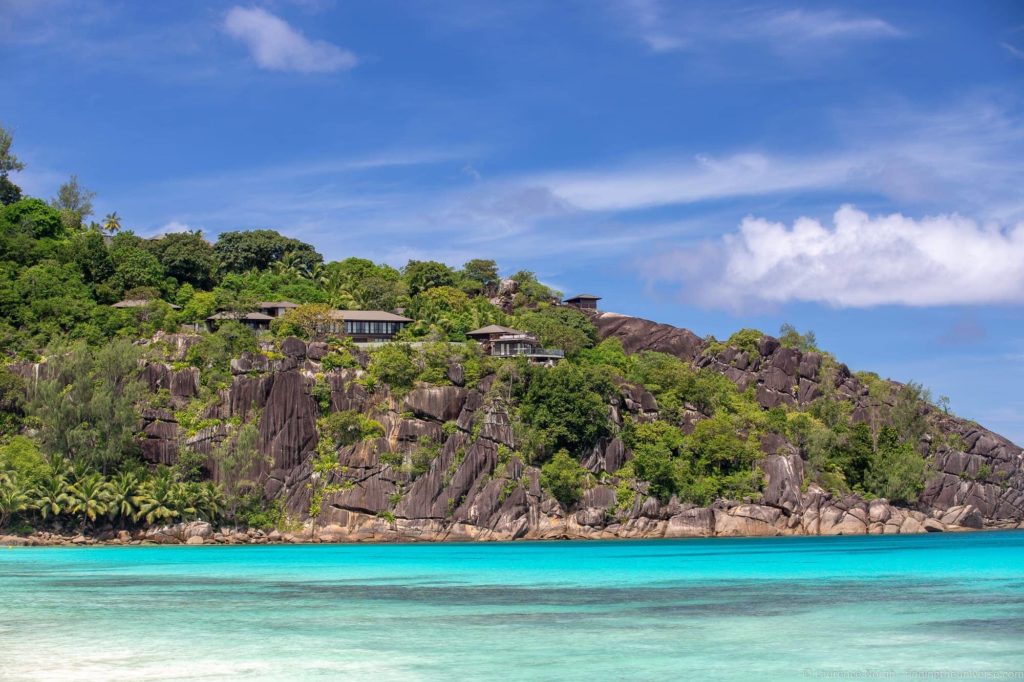
Tours in the Seychelles
Other than the day trip to the “other islands” such as Curieuse, all the activities in our itinerary can be planned and done on your own.
However, if you prefer to take a tour, and leave the hassle of driving and planning to someone else, then there are a few tours that we suggest that line up well with our itinerary. The ones we have chosen include hotel pickups and generally last a full day.
- A full day boat tour of the islands around Praslin, usually including Curieuse and St. Pierre islands, including hotel pickup and lunch
- This is a small group full day tour of Mahe
- This full day Mahe tour focuses on some of the best beaches in the Seychelles
- This is a fully customisable private tour of Mahe
- This full day tour of Praslin includes the Vallee du Mai and Anse Lazio beach
Tours definitely need to be booked in advance.
Further Reading for Visiting the Seychelles
Well, that pretty much sums up our guide to spending one week in the Seychelles! Hopefully you’ve found it useful. We’re in the process of putting together more content to help you plan the perfect Seychelles trip, but in the meantime, you might find the following useful:
- Our guide to the traditional foods of the Seychelles
- Our guide to the best beaches in the Seychelles
- A guide to staying hydrated when travelling
- A Seychelles travel guide
And that’s it! We hope you enjoyed our guide to visiting the Seychelles for a week, and as always, if you have any questions or feedback for us, just let us know in the comments below!
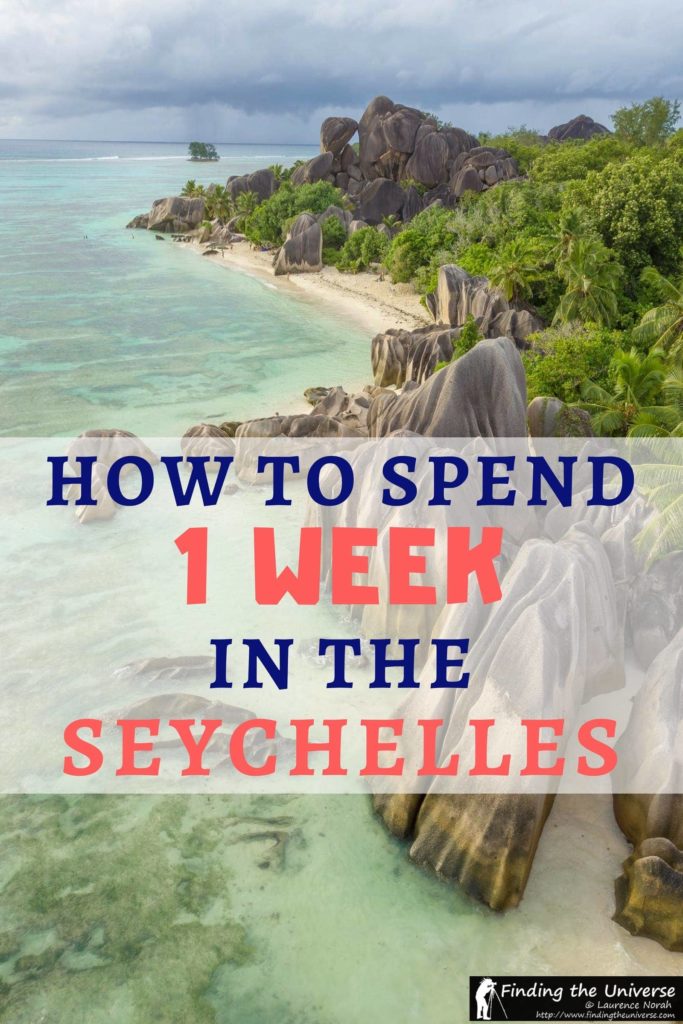
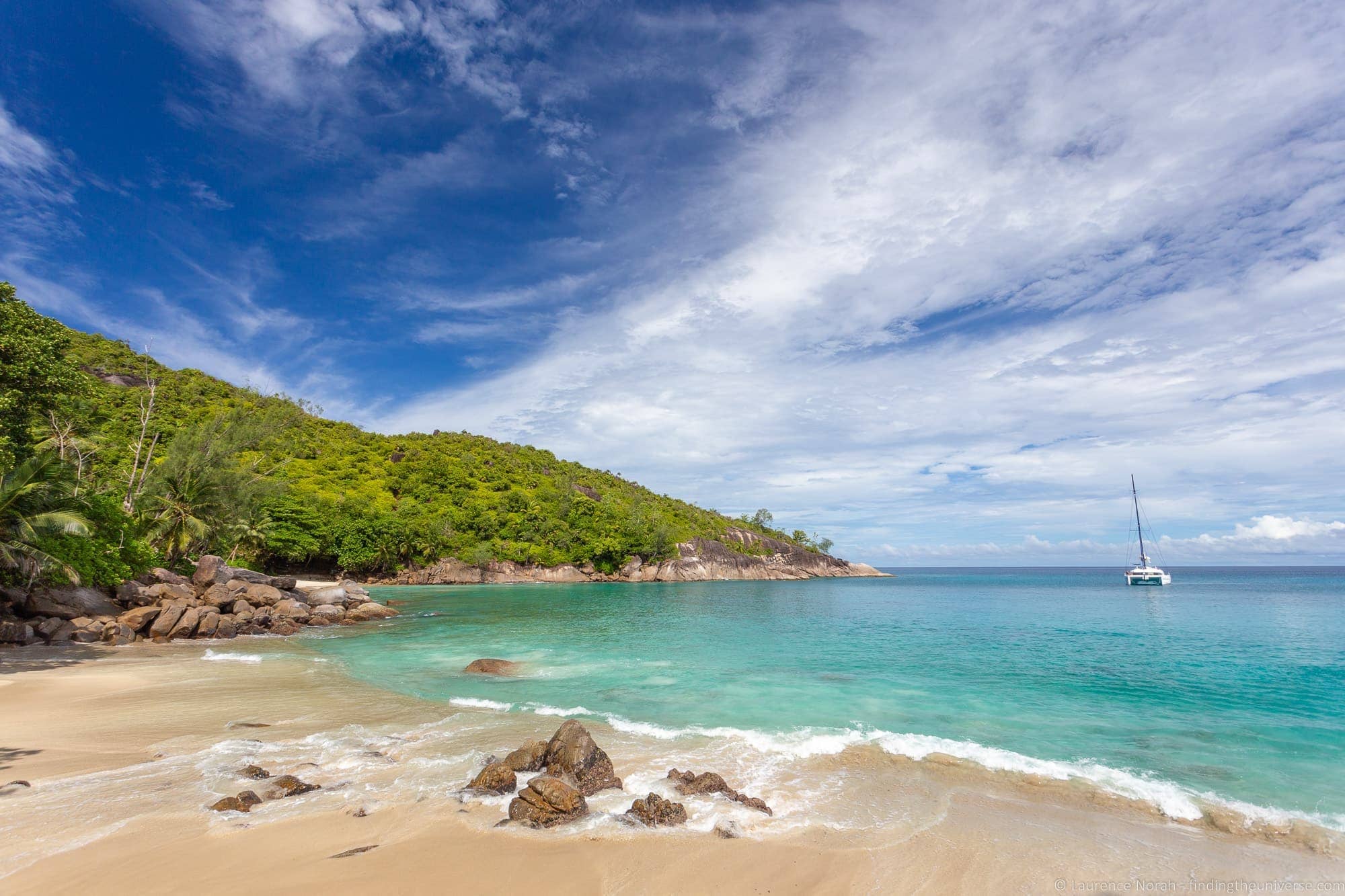
Saurabh says
very well explained! great detailing, my sincere compliments to you. we will be visiting from 28/10 till 3/11 this year for our 25th wedding anniversary. 2n in praslin at acajou hotel, 1 night at LA digue Island Lodge and 3 nights at savoy at Mahe and will try to cover as per your itinerary. in Praslin and Mahe we will take car on rent but
wanted to check what is the best way to transfer at La digue ferry point to LA digue Island Lodge as we will be having luggage.
further are credit cards acceptable at eateries or we need to have euro in cash.
any other suggestion to make the trip more enjoyable will be helpful.
thanks
Laurence Norah says
Hi Saurabh,
Thanks very much!
So La Digue Island Lodge should be able to provide luggage transport services, I would reach out to them to ask. There are golf carts and similar modes of transport which should be able to meet you at the ferry for sure.
For payment, it is definitely worth having some cash on you, but the majority of establishments should accept credit cards now. It’s only the smaller locations where credit cards might not be accepted.
Have a great trip and let me know if you have any more questions 🙂
Laurence
Lidiya says
Excellent write-up! I would like to know about wedding photograph idea if you know
Laurence Norah says
Hi Lidiya
So this is not a personal area of expertise, but if it was me I’d pick one of the beaches. There are some stunning beaches in the Seychelles, (I list my favourite Seychelles beaches here), so that would probably be a starting point personally.
Have a great time in the Seychelles!
Laurence
Marla says
I’m planning a trip for January for 7 nights leaving on the eighth day in the evening.. and your trip seems nearly perfect except people are mentioning different islands and I’m starting to get curious. My question is if I rented a car would I only rent it for the few days I am on Mahe? Is there a trip coordinator that you know that could drive me and coordinate all of these comings and going’s? I am alone. Thank you for any suggestions.
Laurence Norah says
Hi Maria
Thanks for your comment! So obviously there are many islands in the Seychelles, although not all of them can be visited. With 7 or 8 days though our recommendation is not to spread the trip too thin as you will spend more time jumping between the islands rather than seeing them. So of course you could switch out some of the islands, but I think seeing more than 3 islands in a week might be stretching things a bit. For car rental, yes, you would need to do seperate rentals for the different islands. Only Mahe and Praslin really need a car though, most people get around La Digue by bicycle and the other islands like Denis are too small to need anything other than feet!
In terms of trip co-ordination, there are various tour operators that will likely be able to help, but honestly it is likely just going to be as easy to do it yourself if you are planning a custom itinerary.
Have a great time, let me know if you have any more questions!
Best
Laurence
Sagar says
hey thanks for the detailed information.
just a quick question though , can you share any information regarding the new year celebration in seychelles.
I happen to be visiting seychelles along with my wife during this year end , i understand from your write up that it might rain , however just wanted to know are there any parties etc that happen during new year
regards
Laurence Norah says
Hi Sagar,
So New Years Eve is definitely celebrated in the Seychelles, there are a lot of parties to choose from. Most hotels will have some sort of party or event that you can go to and then there are also others to choose from. I don’t have a specific one to recommend but I am sure you will find something!
Best
Laurence
Shania says
Hi Laurence,
Thank you for such a helpful article. We are booked to stay in Mahe for 6 nights in July. We have also booked flights to Praslin and back on the same day – do you think it will be too rushed to visit Praslin and La Digue on the same day and get back to Praslin airport for our 6.15pm flight back to Mahe?
Thanks for your help.
Shania
Laurence Norah says
Hi Shania,
My pleasure! So I would say that yes, a day is going to be a bit rushed to see both Praslin and La Digue. You have to consider that to get from Praslin to La Digue you first have to drive from the airport on Praslin to the ferry terminal, which is a 20 – 30 minute drive. Then there’s a 15-20 minute ferry ride from Praslin to La Digue. So that’s over an hour of your time just transferring. I’d suggest focusing on Praslin, or considering an overnight stay on La Digue, rather than trying to fit it all in. Of course, it is possible, but you probably won’t see as much as you would like.
Have a great trip whatever you decide to do!
Shania says
Thank you for such a prompt reply Laurence! I’ll start looking for accommodation on Praslin or La Digue.
Laurence Norah says
My pleasure! Let me know if you have any more questions 🙂
Oliver Dollard says
Hi Laurence!
Superb work on all of your blogs I’ve learned so so much and you made it all very clear for us, a huge thank you!
I am flying tonight to Mahe, my girlfriend and I are staying for one month in total, with a week on Silhouette island. Of course we plan to visit all the main islands and do the typical activities and beaches.
But we are looking for a very chilled and remote stay, we are more interested in the small shack type bars or a man cooking fish on the side of the beach than the resorts or restaurants. Do you have any advice on spots or how to avoid busy areas?
And a few other questions, sorry!
I would like to do some fishing, but preferably not paying for a boat to take me out. Do you need a rod license? Can you just cast off on the rocks?
Do you have any recommendations on who to use for scuba diving? Also, I would like to try and see a whale shark if possible, I read they are around for a couple more weeks. Can you share any more wisdom?
Any help at all would be brilliant. Thank you so much. Where do your two live now btw? Or do you just travel!?
Thanks again, can’t wait to get there and explore.
Oliver
Laurence Norah says
Hi Oliver!
Thanks very much 😀 Sounds like you have an amazing trip planned! So to be honest, the Seychelles islands as you will quickly discover are not that huge, so the sort of setup you are describing is harder to find. That said, honestly the islands generally aren’t that busy anyway! So some of the beaches are definitely a bit busier than others, say Beau Vallon on Mahe is going to busier than some of the beaches around the south like Anse Intendance. And La Digue tends to be busier in general as it has more budget accommodation options. But it’s still possible to find quieter beaches, the key really is just to go a bit further than others are willing to go, and avoid the most popular options. But I think you’ll quickly see that even a “busy” beach in the Seychelles is quite a distance from a busy beach anywhere else in the world.
For fishing, as far as I know you don’t need a license for recreational fishing from the beach. So as long as you have a rod and some bait, you’re good to go!
For whale sharks, I’ll be honest, I’ve never seen one. I don’t dive, so it’s not really an area of expertise.
Sorry I couldn’t be of more specific help for some of your questions, but I hope you have an amazing month in the Seychelles and do let me know if you have any more questions! Enjoy!
Laurence
Neil says
What is the situation with the seaweed in August? We’re heading to Mahe in a week and we are staying near Anse Royal. Never heard of that issue for Seychelles. We had a really bad experience with the seaweeds in Mexico a few years ago.
We plan to rent a car and browse most of the beaches you recommended here.
Also which are the best places to exchange money?
Laurence Norah says
Hi Neil,
So the south east would be when the beaches on the south and east of the island are more affected by seaweed, which will include Anse Royale. Unfortunately I can’t tell you exactly how it will be, because it varies each year, but certainly there is a good chance that there will be some seaweed. However, if you have a car then it is a short drive to the other side of the island which should be seaweed free.
I’ve also reached out to my family members who live near Anse Royale for an up to date report, if they get back to me I’ll let you know!
Best
Laurence
Laurence Norah says
Hi Neil,
Just to update my previous comment, my cousin drove past Anse Royale beach a few minutes ago and said there currently isn’t any seaweed. However, it’s worth being aware that with the wind on that side of the island the water will be a bit choppy.
Enjoy your holiday!
Laurence
ETI BITON says
HII Laurence,
thank you so much for your great 1-week itenerary.
It was very helpful to us in planning our week in the Seychelles.
– I would like to consult with you.
My husband and I plan to travel at the end of September for a week.
And I would like to know which side of Mahe and La Digue better in terms of clean beaches without seaweed and calm water on the end of September.
Thank you,
Eti
Laurence Norah says
Hi Eti,
My pleasure. So September is the South-East, which means the wind blows from the south east, and beaches on the south east of the islands will be more affected. So on Mahe you would want to stay in the north west or west side. La Digue does not get too affected, and the hotels are mostly on the west anyway 🙂
I hope this helps – have a great trip and let me know if you have any more questions!
Laurence
ETI says
Hi Laurence,
Thank you very much.
It was very helpful to me.
Eti.
ETI BITON says
Hi Laurence,
Asks for your opinion on the division of days based on your recommendation for one week in the Seychelles.
We land in Maha and from there fly straight to Praslin. Landing in Praslin at 19:00.
We would like to get straight to La Digue that evening, but do not think there will be a ferry there at such an hour.
Is it possible to find a cruise to La Digue from Praslin in the evening?
Option number one – to spend the first night in Praslin near the port and at the next morning to sail to La Digue for two days.
Return to Praslin for another two days and on the third day morning we have a flight at 10:40 to Mahe.
Disadvantage – 3 hotels in a short time – one night in Praslin + 2 nights in La Digue + and again Praslin for 2 nights.
Option number two – stay in Praslin after landing for another 2 days and then sail to La Digue for two days.
On the third day early in the morning, sail from La Digue to Praslin, to get the fligh to Maha at 10:40.
Disadvantage – afraid that we will not be able to get to the flight at 10:40 in the morning when we have to get there from La Digue.
In Maha we will be 3 days.
Which of the two options do you think is better?
I would love to have your opinion.
Thank’s, ETI
Laurence Norah says
Hi Eti,
You are correct – the last ferry currently from Praslin to la Digue is at around 2.30pm. So getting straight to La Digue on your arrival day isn’t going to be possible. I’m not aware of any other transport options either, so you would be better off staying on Praslin and then going to La Digue. My suggestion would be to spend two nights on Praslin, then go to La Digue. You shouldn’t have a problem making the 10.40 flight from Praslin as you can get a ferry from La Digue at 7.30 which gets you to Praslin at 7.45, more than enough time to get across the island. My only query is that it would probably be easier and faster to just get the ferry from Praslin to Mahe. It only takes 75 minutes, and connects with the La Digue ferry.
Of course, if you already have the flight tickets booked and can’t cancel them that would still work. I’d definitely go with Option two though 🙂
Best
Laurence
Elan says
Laurence,
What about the other side of the Island—near Anse Royale? Given the season, would the sea be calmer and more clear on that side? Though I note there are not many hotels on that side. Thank you again!
Elan
Laurence Norah says
Hi Elan,
So there are two main types of beach in Seychelles – those behind a reef, and those that are clear water. The Anse Royale side of the island is mostly behind a large reef, which means the water can be very shallow and full of coral. It’s not good for swimming and this is why there aren’t many hotels on that side of the island. If you are looking for good swimming in clear water then I wouldn’t recommend it,
Best
Laurence
Elan says
Hi Laurence,
Sorry to bother you again, but you are the most knowledgeable person I have found about this issue. You mentioned the seaweed issue, but what about strong currents in North of Mahe vs. South in January? Someone mentioned that in the north ( Northholme area) of the island it could be very strong currents and almost on swimmable. Is that accurate? Thank you for your help. And would it be the same in south west side?
Thank you again
Elan
Laurence Norah says
Hi Elan,
No worries. So some beaches in Seychelles can have currents. I’m not familiar with the Northholme beach – it’s very small and not one most people would visit unless staying in the hotel. However from there you are very close to the Beau Vallon beach which is regarded as one of the safest beaches for swimming. So maybe you might instead consider a hotel on Beau Vallon. Port Launay is also a safe beach for swimming 🙂
Laurence
elan zivotofsky says
Laurence,
thank you so much for your great 1-week itenerary. I wanted to ask your views on a couple of things. Your answers will be most appreciated and helpful.
My wife and I are planning a 1 week trip in early January. I am aware it is the rainy season, but it is okay with us. We are considering doing the first 3 nights on Denis Island, which looks amazing. We are focused on outdoors (beaches, snorkeling, water sports, etc). But, that will limit the time we have for other islands. We would then only have 4 days left, which I was thinking of staying on Mahe, and maybe a 1-day quick trip to La Digue? Is this a mistake? Should I do La Digue instead of Denis? would love any thoughts you have.
Regarding Mahe-I was considering The Northolme Hilton which looks really nice and I have heard good things about. BUT, in January, would you suggest not staying up on that part of the island? Is Constance Ephelia a little better from that perspective. And, in the south, anywhere high end you would reccomend other then Four Seasons (which is pricey)? thank you So much for your help.
Elan
Laurence Norah says
Hi Elan,
It’s my pleasure and I am of course happy to help!
So in this itinerary as you’ll have noticed I didn’t include the islands like Bird or Denis, just for time reasons. However, they are definitely beautiful. I am a little biased as I lived on Bird Island for many years, but I believe the hotel is being renovated at the moment. It’s also quite a rustic experience, wheras I think Denis is a bit more up to date. That said, I’ve not actually visited Denis since the mid 90s, although my brother has been in the past few years and said it was lovely.
Personally I would pick Denis over La Digue. It’s going to be a much quieter and relaxing experience. La Digue is lovely, but it is quite a popular destination and also has many more budget accommodation options, so can become quite busy. Although that’s probably not the case at the moment.
I think your plan of Denis / Mahe + 1 day to La Digue is definitely do-able. For Mahe, the north side of the island tends to be more seaweed prone from November – March, which is during the “north-west” trade winds season. However Mahe doesn’t get so affected honestly at this time of year, it’s Praslin that has more issues. The seaweed on Mahe tends to be more in the South-East trade winds, and on the south side of the island. It is of course possible depending on the conditions that there will be some seaweed, but it shouldn’t be a lot. However, if you’d rather not risk it, then Constance Ephelia is nice. The beach there is also spectacular and great for snorkelling, and I also really love the drive over Sans Souci.
The Four Seasons is expensive but deservedly so, it’s on one of my favourite beaches and the resort is gorgeous. You might instead try the nearby Kempinski which I believe is more reasonably priced although the beach is not so spectacular in my opinion. I would probably go for the Constance if it was me. There was also the Banyan Tree on Anse Intendance, but it’s closed for a couple of years for renovations at the moment unfortuantely.
I hope this helps, happy to provide more information if required! Otherwise I hope you have a wonderful trip, I’d love to hear your experiences and thoughts when you return 🙂
Laurence
elan zivotofsky says
Laurence,
Your answer is extremely helpful. I am considering the Four Seasons — just not sure I am ready to pay up that much. Constance Ephelia looks like a great location, but I am just a bit concerned as it is a very BIG resort with likely a lot of people as compared to the Northolme Hilton. Can you just compare those locations if you know the Hilton at all? thank you so much for your help!.
Also, I am happy to hear you think 1-day go and return to La Digue is doable. would likely fly over to Praslin and head to La Digue. Would be a long day, but sounds like you think it can be done.
Elan
Laurence Norah says
Hi Elan,
So it depends a little on what you want from a hotel in terms of location. I’ve not stayed at or visited the Hilton, but I do know based on its location that there isn’t really a great beach on site. There is a small beach, but it’s quite a cosy affair. Constance has access to two beaches, one of which (Port Launay) is regarded by many as one of the best beaches on the island.
I’d also add that I haven’t stayed at either resort so I can’t comment specifically on staying at them.
For La Digue, as well as flying I’d recommend investigating taking the Cat Cocos boat. Whilst the flight time from Mahe -> Praslin is quicker, once you factor in waiting at the airport, and then having to get to the other side of the island to the port where the Praslin -> La Digue boat goes from, you might find it’s easier to take the Cat Cocos from Mahe – Praslin (1 hour) and then directly transfer to the Praslin -> La Digue boat (the schedules are usually well aligned to make this easy).
Either way, you’ll want to confirm the timetables to make sure it’s all possible in a day.
Best
Laurence
Harris says
Hi Laurence,
It was an interesting and full of useful information blog, however, I’m confused with the stay on your 4th/5th/6th day. Did you stay at different island everyday? Could you please describe a little about the accommodation arrangement as well (booked online or can book once reach there)?
Also, I’m travelling with my wife next month. Which part of Seychelles you will suggest us to stay?
Thanks in advance!
Harris
Laurence Norah says
Hi Harris,
The itinerary has you spending three nights on Mahe, then two nights on Praslin and one or two on La Digue. So yes you have to change islands, and the instructions for how to do this are in the post. For the hotels, I generally recommend booking in advance so you know where you are going and can arrange transportation. We always book online in advance of our travels these days so we don’t have to worry about finding somewhere when we arrive, and also because places can book up in advance at busier times of year.
In terms of where to stay, the main concern visitors usually have is over the seaweed, which can affect different beaches at different times of year. January is the North West season, so the winds blows from the north west, meaning it’s best to avoid beaches and accommodation on the north west of the islands as they are more likely to have sea weed. So if you look at a map of the island, I’d suggest avoiding say Beau Vallon on the north west of Mahe, and instead heading to the south east.
Of course, this is just a suggestion, and the beaches are not always affected by seaweed 🙂
Have a great trip!
Laurence
Rizwana says
Excellent blog – to the point and so many invaluable tips. We are a young family of 5 based in Abu Dhabi – Boys aged 7, 5 and our princess aged one year old. Just one thing – is halal food available easily especially at decent hotels – we are planning:
1) March 27 to 30 (3 nights as per your suggestion)- Le Méridien Fisherman’s Cove in Mahe – We have only taken breakfast option as I assume Mahe should have easy food options
2) March 30 to April 2 – (3 nights on half board – although having read your article maybe I need to reduce and no need to go half board): Constance Lemuria Hotel – I have been told its an excellent option although very expensive
3) April 2 to 4 – (2 nights as 1 night maybe too little with small kids) – Maybe stay at Oceane Self Catering – since the booking is non-refundable, just need to maybe wait a bit closer to date before booking it.
Many thanks again for your invaluable advice
Laurence Norah says
Hi Rizwana,
Thank you very much, I am delighted to have been able to help. It sounds like you have a wonderful plan.
I am often asked about hotels and where to stay in the Seychelles, so I have gone through and updated the accommodation section with some detailed recommendations.
In terms of your accommodation options I think you have made some great choices 🙂 For Mahe, you will definitely not have any problems finding places to eat, especially from the Fisherman’s Cove as Beau Vallon has quite a few options to choose from. Fun fact, my Dad actually used to be the assistant manager at the Fisherman’s Cove… but that was quite a long time ago!
Constance Lemuria is a fantastic property. We haven’t stayed there (we did just stay at a Constance property in Mauritius though which was lovely), but we have visited, and the beaches on the property are some of my favourite in the islands. I don’t think you will be disappointed. I will say that if you don’t plan on eating at the hotel you might want a hire car, as the hotel does not have a lot of restaurants nearby. So you might find half board an easier option.
We really enjoyed Oceane Self Catering, although it is obviously a bit more of a budget option that Lemuria! However the rooms were very nice and the staff were really friendly. This is a great place to try some local food. However, if you did want something a bit less budget focused, you might consider some of the other options I’ve added to the post. La Digue is very small and easy to get around, so you definitely don’t need full or half board here, and there are quite a few dining options.
Have an amazing trip!
Laurence
shailesh jani says
Hi,
We , friends are planning to visit Seychelles by January End or February start, Please guide how would be the weather there in this two months ? Looking forward your Reply on our mail id please.
Laurence Norah says
Hi Shailesh,
It’s hard to give precise weather information as the weather in Seychelles is variable. January / February is at the end of the rainy season, but this just means that it is more likely it will rain from time to time rather than rain all day. Traditionally February is one of the hotter times in Seychelles, so you should have good weather and calm seas, and it should be good for snorkelling as well. On the larger islands, it will rain most days, but in isolated locations and only for short periods.
I hope this helps!
Best
Laurence
SHAILESH JANI says
Dear Laurence
Thank you so much for the guidance. It looks from your Reply instead of January we should visit in Mid February right, so weather is clean and sea is calm as well and we can enjoy Sunset and Sunrise and cruising and boating also in Feb.
Thanks so much once again dear for your prompt reply. I will be in touch with you now and even after arriving at your beautiful Island.
With Warm Regards
Shailesh Jani
Laurence Norah says
My pleasure. Yes, I would say February would be an excellent month to visit 🙂 Have a wonderful trip!
Laurence
Jagadish says
Excellent write-up. Very useful. One stop solution capturing everything one needs to know before touring Seychelles!!!! Truly appreciate it.
Laurence Norah says
Thanks very much!
PRADEEP says
Hi Laurence,
Can you suggest me best boat tour service provider in praslin apart from the one you mentioned in this blog
Laurence Norah says
Hi Pradeep,
There are a number of companies out there, however we haven’t used them personally, so any recommendation would just be based on my Googling reviews from other traveller, so would not be a genuine personal recommendation. I wouldn’t want to recommend something that we don’t know personally, so the best option might be to take a look at what is available, and see if there are recent reviews from other travellers that might let you know if it’s a good company or not,
Have a great trip!
Laurence
Alan says
Wonderful article. Are there opportunities to sail, either chartered with a captain, or rented for us to pilot ourselves. Powerboat rentals would be interesting as well.
Thanks!!
Alan
Laurence Norah says
Hi Alan,
It is absolutely possible to hire a yacht in the Seychelles, either with a skipper or without. However, I have to be honest and say that I have not done this myself, and so I would not be able to personally recommend a service as we haven’t tried one. However, it is definitely possible. I’m not sure about power boat rentals however,
Have a great trip!
Laurence
Tammy says
Hi!
Thanks for great article, it is very helpful.
I noted several questions regarding the weather, so i won’t nudge again about it, though I’d love to get your opinion on a visit at early March.
I am though trying to understand the Trade wind issue. if I got it correct if affects the clear water and the algae. So, how is March? and if we plan to stay only in Mahe – is there optimal side/beaches that aren’t affected?
Thanks so much in advance!
Laurence Norah says
Hi Tammy!
No worries on the weather question, I’m happy to try and help. The only problem is that the Seychelles, like the rest of the world, is experiencing different weather patterns to that which it has traditionally had. So whilst I can comment on what it *should* do, this seems to not always match up to the reality!
You are correct generally – the trade winds affect the clarity of the water, and then the seaweed (not the algae). The south east trade winds tend to blow from May to September. These are stronger winds than the opposite North West season, which means the seas are more agitated, which moves the sand and other debris around in the sea more, resulting in less clear waters. That is also the season when there is more sea weed on the beaches, particularly on the south and west coasts of the islands, as it is blown ashore.
The good news is that March doesn’t really get these issues. It’s also traditionally one of the warmer and drier months, although, I can’t guarantee that 😉
Hopefully this helps!
Have a great trip, and do report back on your experience once you’ve visited, we love to hear how people’s adventures went!
Laurence
T K Pradeep says
Hi Laurence,
I am planning visit Seychelles this November 2nd week. Is it a best time to visit.
Laurence Norah says
Hi T K,
November can be more rainy than other times of year because it is the rainy season, however, in my experience in the last 30 years or so, the weather is not that reliable so it can rain or not! Just because it is the rainy season doesn’t mean it will be wet all the time. I’ve had weeks of rain in the dry season, and weeks of dry weather in the rainy season.
Even if it does rain, it is usually isolated to parts of the island and there will usually be periods of sun and rain.
The driest and hottest time is traditionally in April, but again, this isn’t guaranteed.
Have a great trip
Laurence
T K Pradeep says
Hi wat exactly this self catering hotels means
Laurence Norah says
Hi,
Self catering means that the property features a kitchen you can use yourself, so you can “self cater”. They usually also have a living area and feel more like a house or apartment than a traditional hotel. Some of them do include a restaurant or the option to order meals, but this varies.
I hope this helps 🙂
Laurence
Vaibhav Kakkar says
Thanks Laurence. This article is excellent in all forms and contains everything that a person needs. Kudos to you!
I am planning a trip in December 19 for 7N/8D. I am thinking to spend 3 nights in Mahe, 2 nights in Praslin and 2 nights in La Digue. Now on the 8th Day, I have a early morning flight (5 AM) from Mahe. So, I am wondering if I can start my trip from La Digue (2 N) followed by Praslin (2 N) and then Mahe (3 N). This way I could easily roam around Mahe on the last day and leave for airport well in time. Would you recommend this?
Thanks!
Laurence Norah says
Hi Vaibhav!
It certainly will work in a different order, I see no reason why not. You will just go from quieter islands to busier islands, but you might enjoy that more as you can relax at the start of the trip and then do a bit more exploring as you go on 🙂
Have a great time!
Laurence
Uzo says
Hello Laurence,
I am so glad to have come across this blog post; I have been trying to figure out where to start on planning a vacay to Seychelles. I am planning to visit Seychelles for my birthday, in January 2020. I have some questions that I hope you may be able to answer. I am a person that likes interactive activities so I would like to know if the islands have access to zoos, museums and other attractions besides beaches. Next, I am vegan so I would like to know if there are any traditional dishes of the Seychelles that just happen to be vegan or if some restaurants on the islands offer vegan options? Lastly, I will be traveling from the US and I will most likely be traveling alone; how much money would you suggest I bring along with me to fund a full 5-day vacation stay at Seychelles? P.S I will be using a combination of public transportation and drivers to navigate around the islands. I look forward to hearing back from you. Thank you!
-Uzo 🙂
Laurence Norah says
Hi Uzo,
There are some museums in the Seychelles, but they are quite small and will not take up much of your time. There are no zoos exactly, but there are plenty of wildlife viewing opportunities. However, the Seychelles is definitely more geared towards relaxing on the beach rather than activities, so it might not be the best destination for you. In terms of vegan food, there are certainly vegan dishes like lentil curries, vegetable curries and banana dishes, however you would have to check with each restaurant you visit regarding their vegan options 🙂
For 5 days the cost will very much depend on your travel style, but I would budget $200 – $400 per day including meals accommodation and transport.
Have a great trip and let me know if you need anything else!
Laurence
Misty Montgomery says
Hi, this is a wonderful article! We are planning our honeymoon for June of next year and had thought it was a good time due to the dry season. However, I’ve been watching the weather and it’s been raining with thunderstorms all month! Do you think this is an unusual weather pattern? I know you’re not a weather expert but am hoping you might be able to provide some insight with your experience in living there.
Thank you so much!
Laurence Norah says
Hi Misty,
So the Seychelles weather is kind of hard to predict, but being an island nation most weather systems don’t tend to hang around very long. It’s quite common for it to have a bit of a thunderstorm on most afternoons, just as the heat builds up in the day it creates them. They don’t usually last very long and tend to be fairly localized. However, when you look at a forecast, they always pick the worst part of the weather to show. I would say that it shouldn’t be wet all the time – usually if it rains it would be for a short period and then clear again. Of course, you can always be unlucky, but it would be unlikely to have many days of rain set in, unless there’s a big weather system across the whole area.
I hope this helps – have a wonderful trip 😀
Laurence
Rebecca says
Hi. Thanks so much for the excellent article. My husband and I are planning a visit from the 20th of December for a week. I am a little concerned about the weather. Is the rain just for a few hours each day,, can we still do something each day? Will we be able to do walking and light hikes?
Thanks
Laurence Norah says
Hi Rebecca,
Usually it just rains for a brief period in the afternoons and is sunny the rest of the time. Of course, you can be unlucky, and the weather is hard to predict, but that is the normal pattern.
Have a great trip!
Laurence
Cheri says
Did you have the 2 week itinerary? I did not see a link.
Thank you!
Laurence Norah says
Hi Cheti,
No, it’s still on the to-do list! However, our advice if you have more time would be to add on another island, like Bird, Denis, Fregate, North or Cousine, depending on your budget.
Have a great trip!
Laurence
Vijay says
Hi Laurence,
Great post!
Me and my wife are planning to go for honeymoon in August for 6 days. So covering 3 islands isnt an option with hectic schedule.
I am in a switch on whether to leave Praslin or Mahe?
What would you suggest ?
Tentative itinerary for now is 3 days in Praslin , 1 day in Ladigue , 1 day in Mahe and return back from Mahe airport.
Awaiting your reply !
Laurence Norah says
Hi Vijay,
Thanks very much!
Well it depends on what you want to do 🙂 There is a lot more to do on Mahe in terms of beaches to choose from and restaurants and other sights to explore. Praslin has the Vallee du Mai and of course some nice beaches, but the island is a lot smaller. It’s also less busy and feel more laid back. So if you just want to relax on a beach and not stress about sight-seeing too much, Praslin is a great option.
I hope this helps – have a great trip 🙂
Laurence
Hana Chundelova Sulcova says
Hi Laurence,
Great article and very helpful as we fly there on the 1st of June for the first time. We have 14 nights in front of us with booked self-catering accommodation close to petite police beach. What beach would you recommend for snorkling this time of a year. Are there many mosquitos now?
Based on your comments I’m just planning to spend 1 or 2 nights on La Dique.
Many thanks.
Best regards
Hana
Laurence Norah says
Hi Hana,
That is a beautiful part of the island, you will have a lovely time. I’d suggest for snorkelling that you consider either Anse Royale or any of the beaches on the west coast, inclduding Anse Takamaka or Baie Lazare. Petite Anse is also nice.
The time you are visiting is during the south east trade winds, so there is more of a breeze and there should be less mosquitoes. However, there are always likely to be mosquitoes, especially around dawn and dusk, so I’d advise taking precautions at those times at least.
Have a fabulous time – we’d love to hear your thoughts on your experiences when you return!
Laurence
Hana says
Thanks a lot! Good news with the breeze. I will definitely get back with our experiences. Our car is booked as we plan to hike to those less accessible beaches.
Best regards Hana
Shuchita patni says
Hi Laurence,
Thanks for the details. It is really helpful. I am planning to go to Seychelles in August 2019. Will there be water sports on during that time?
Thanks
Laurence Norah says
Hi Shuchita,
It depends which watersports you are interested in – but the main stretches of beach like Beau Vallon usually have a variety of watersports options available year round 🙂
Enjoy your trip!
Laurence
shuchita patni says
Thanks Laurence. I want to do scuba diving or snorkeling.
Also pls let me know if Seychelles is safe for solo traveler as a woman.
Regards
Shuchita
Laurence Norah says
Hi Shuchita
Snorkelling and scuba diving will definitely both be possible 🙂
For the safety aspect, my general response is that yes, the Seychelles is safe for solo female travellers. However, I must of course add that this is not a personal area of expertise for me. Naturally I’d advise taking any precautions you normally would when travelling alone in a foreign country. That said, on the whole Seychelles is regarded as a safe country, violent crime is very low, and the main risks are petty theft of valuables (i.e. don’t leave any expensive items unattended on the beach whilst you go for a swim).
I hope this all helps,
Laurence
rohit nigam says
Hi Laurence,
Thanks for very intuitive and detailed post.
I am planning on honeymoon trip around Nov and December in 2019 for 6-7 days.
As per your post I find La Digue and Mahe more attractive amongst 3. I don’t want to travel much and to travel all 3 island might be hectic. Can you please let me know travel plan for these 2 islands or any additional suggestions you might want ?
Also please suggest some good hotels for honeymoon in both these places which might have private pool. and also some good budget hotels
Kindly give your valuable input alongside.
Laurence Norah says
Hi Rohit,
My pleasure, and thanks for your comment! So I would likely spend 4-5 days on Mahe and 2-3 days on La Digue in that case. There is a lot to do and see on Mahe if you want to get out, and a wide choice of beaches to explore.
Many hotels feature private pools, such as the Banyan Tree on Intendenance Beach or some of the hotel hotels mentioned in this post, like the Four Seasons. Certainly, hotels with private pools are generally not in the budget category though. I will be updating this post in the coming days with some more hotel recommendations as I have been asked for this, so stay tuned for an update 🙂
Laurence
Nunayon Ahisu says
Thank you so much for this education, i am travelling this may to Seychelles for 7days (surprise my wife), and will love to visit the three major islands, in the other you have advised, but i am confused about how to switch bookings on accomodation, so i could spend quality day & night on these Islands.
1). Considering the customs, and visa issues, i need to book online before arrival
a). Should I book for the first 3 nights in Mahe, and the others when arrive
b). Must I book all the seven days online before arrival
c). Are there other things i need to do online before arrival
d). I am actually at a loss on how to handle these bookings
Please advise.
Laurence Norah says
Hi Nunayon,
My pleasure, it sounds like you have a great trip coming up. I will answer your questions to help you with your trip of course 🙂
a – You definitely need to book your first nights before you arrive. When you arrive in Seychelles, you will be asked by the immigration officer where you are staying, and so you need to have the address or name of your hotel available.
b – I would personally advise booking all your hotels in advance of your arrival, so you can enjoy your trip rather than trying to find somewhere to stay.
c – I do not know where you are travelling from. Most countries I believe have a visa on arrival into the Seychelles, but it is always worth checking. If you are travelling from a nation with Yellow fever or other diseases, you may also need proof of vaccination. These are things you would need to check on the Seychelles immigration website.
d – our preferred website for online booking is booking.com – you can see all the hotels I recommend have links so you can book directly. You can also use the map feature to find properties where you want to be, and filter them by price and all sorts of other features.
I hope this helps – have a lovely trip!
Laurence
Dele says
Thank you for this write up. You have virtually made it so easy. I’m going in August for my honeymoon. Surprising my wife with this trip and this has really helped! Although we are there for 2 weeks. Do you mind recommending more hotels in the locations you listed?
Laurence Norah says
Hi Dele,
Our pleasure, and I hope you have a wonderful time! It’s hard to recommend hotels as there is so much variation in price, however I would suggest using the link in the post and refining by budget and location to help. I will also look to add some more suggestions to the post to help people out, across a range of budgets.
Best
Laurence
Raman says
Hi Lawrence. Excellent information.
I am planning a trip of 1 week to Seychelles in August 2019. Is August good time to visit?
Are there night clubs in plenty?
I had read somewhere about the transportation (especially bus) from the airport to the city which is not having frequent service. What about taxi service from airport? Is taxi negotiable or there is taxi mafia? Further is there any time limit for the ferries such as last ferry time in the eve so it will be easier to plan accordingly else I would be stuck on an island while my hotel would be on another island.
Laurence Norah says
Hi Raman,
August is a good month – it is the dry season so you are less likely to get rain, and there is usually a nice south east breeze meaning it won’t be too hot. The only downside is that there can be seaweed on some of the beaches, particularly Grand Anse on Praslin.
There are some nightclubs in the Seychelles, but I would not say plenty – it’s more of a beach destination than a party destination for sure.
There are plenty of buses and they are quite frequent. However, sometimes they won’t let you board with large bags. There are plenty of taxis and usually they are metered, however you can negotiate a fare in advance if you prefer.
There are regular ferries between the main islands, but they do run to a schedule and don’t run all night. However, it’s only really between the three main islands, Mahe, Praslin and La Digue. I think you would definitely want to plan your visit to the islands around the ferry times so as not to be stuck!
Enjoy your trip!
Laurence
Gidraph says
Hello Great write up and very informative.
Good job!. Never been in Seychelles and have been thinking of it for my honeymoon in early May for like a week.
I like the itinerary guide, sounds a great plan.
Where would you recommend for a hotel?
Which is the best airline from Nairobi?
Thanks
Laurence Norah says
Hi Gidraph,
So if you follow the itinerary you will see I have put hotel recommendations in. For flights, the only direct flights from Nairobi are with Kenya Airways, so I would recommend those,
have a great time!
Laurence
SUSANTA GHOSH. says
IT IS A VERY GOOD ISLAND , I AM AN INDIAN BUT I HAVE BEEN AT SEYCHELLES TOTAL THREE(03) YRS BUT NOT FOR TRAVEL IT WAS JOB AT SPDF.
NAME- SUSANTA GHOSH.
Laurence Norah says
Thanks for your comment Susanta 🙂
Kristianna says
Hi,
Thanks for putting this together, so useful! Have you released the two week guide?
Laurence Norah says
Hey Kristianna! It’s still on our to-do list. But if I had two weeks, I would probably add in some time visiting some of the other islands like Bird or Denis for a couple of days at least 🙂 If you subscribe to our newsletter you’ll be the first to know when that post goes live 🙂
Rohit says
Hi Laurence & Jessica,
You guys are amazing, nice write-up. You have given pretty much a proper travel plan, great job. Enjoy your travelling and keep writing.
Good Day!
Cheers
Rohit
Laurence Norah says
Thanks Rohit – have a great trip 😀
Gaurav says
Dear Laurence & Jessica,
Thanks for sharing such informational Blog!! I am planning to travel to Sechyelles in Feb. ’19 along with my wife and 1 yr kid. Have couple of questions
1). Do we get vegetarian food (preferably Indian Veg Food) in Seychelles?
2). Are there good medical facilities on Praslin and La Digue? This question is more from my kid’s perspective.
3). For renting a car, is International driving licence must ?
4). Is Visa on arrival facility available ?
5). Pls provide more information on other travel options like Bird Island or Denis Island..
Thanks!!
Gaurav
Laurence Norah says
Hi Gaurav,
Thanks very much. Sounds like you’ve got a great trip coming up. I’ll try to answer your questions 🙂
1 – Seychelles food is very similar to Indian food, with a lot of curries especially. The main dishes are fish based, but vegetable curries, rice and lentils are also very popular, so you should be fine.
2 – There’s a hospital on Praslin, and a small island hospital on La Digue. However I have never visited or used these facilities so I cannot comment on how good they are. Also, I am not really able to provide advice as to whether they would be suitable for your child
3 – For renting a car I believe you only need a license to be written in a Latin language like English, rather than something like Chinese or Russian characters. So generally an IDP should not be necessary. However you can always check with the car rental agency if you are not sure
4 – The visa system for Seychelles is generally issued on arrival. I will guess you have an Indian passport based on your food preference 🙂 So you do not need a visa – the tourist visa valid for 30 days will be issued on arrival. You just need proof of onward transportation, proof of booked accommodation, and proof of sufficient funds to support your stay. You can see more advice here: http://www.mfa.gov.sc/static.php?content_id=1
5 – There are lots more options depending on your interests and we plan to write more content about these, however we’ve not had time as yet unfortunately. Bird and Denis are both lovely islands, they are very quiet though, and more for lovers of nature who just want to relax, as there is not much to do other than enjoy nature and the beach.
I hope this helps – have a wonderful trip!
Laurence
Gaurav says
Hi Laurence,
Thanks for the quick revert. The information provided by you is really helpful!..Wish you all the best for your blogs..!!
Thanks
Gaurav
Rohit says
Lovely in depth article. My visit to Seychelles includes a Sunday in between. Is mahe shut on Sundays?
Laurence Norah says
Thanks Rohit! So the beaches and so on are all open (and popular!) on Sundays. However, many shops and attractions will be closed. It’s best to check individual attractions that you want to visit to see if their opening hours are different on a Sunday.
Have a wonderful trip, and let us know if you have any more questions!
Laurence
Archana says
Hi Lawrence ,
Excellent Information .
We will be visiting in January 2019 for one week . Plan is 3 nights Praslin 1 night La digue and 3 nights Mahe.
Please suggest good options for stay with self catering apartments/airbnb
Laurence Norah says
Hey Archana!
Thanks very much 🙂
Our suggestions for accommodation are in the post in the section under where to stay (https://www.findingtheuniverse.com/visiting-the-seychelles-a-1-week-seychelles-itinerary/#Where-to-Stay-in-the-Seychelles)
We haven’t personally stayed in a self-catering on Praslin so don’t have first hand experience to share, although there are lots of options to choose from. On Mahe, we recommend Villa Kordia, and on La Digue we stayed at Oceane Self Catering, both of which are self catering 🙂
Have a great trip!
Ajith Menon says
Excellent information. This was exactly what I was looking for my Seychelles holiday. Thanks much
Laurence Norah says
Our pleasure Ajith – have a lovely trip!
Ajith Menon says
Hi Lawrence,
If I need to do a 9 day or 10 day stay what would you recommend. For e.g. 4 days Mahe, 3 days Praslin and 2-3 days in La Digue. Thanks for your help.
Laurence Norah says
Hi Ajith!
To be honest, with 9 or 10 days I would add on one of the other islands, like Bird Island or Denis Island. These are worth a couple of days, and are quite different from the other islands, so are definitely worth considering 🙂
I hope this helps!
Have a great trip 🙂
Laurence
Lombok Wander says
Nice beach and nice view !
Laurence Norah says
thanks!
Scott says
Excellent write-up! And surprisingly, it doesn’t seem as expensive as I first thought it was.
Laurence Norah says
Thanks very much Scott! It can definitely be done on a reasonable budget, especially if you don’t go crazy with the high end hotels 😀
Solomon pindar maiva says
Very nice beach, and a place to be, I wish to leave there.
Laurence Norah says
I hope you do 🙂